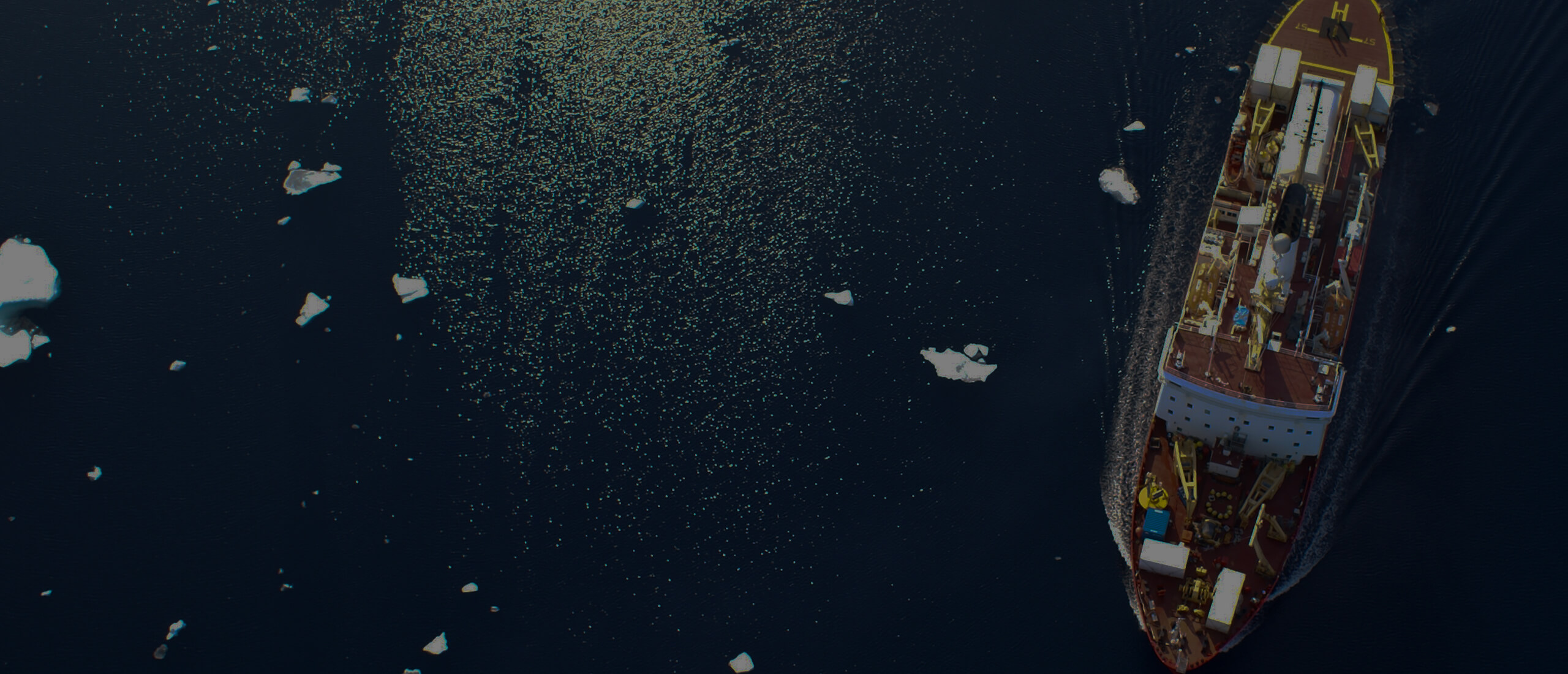Day 12 - Time flies
July 23 - Vanessa Pitusi, Marion Lebrun, Emiliano Cimoli, Raphaël Larouche
The Sentinel North International PhD school is almost over. It's already been 12 days, an incredible journey during which we experienced many different landscapes, aspects of science and people – both on the ship (science and crew) as well as northern communities.
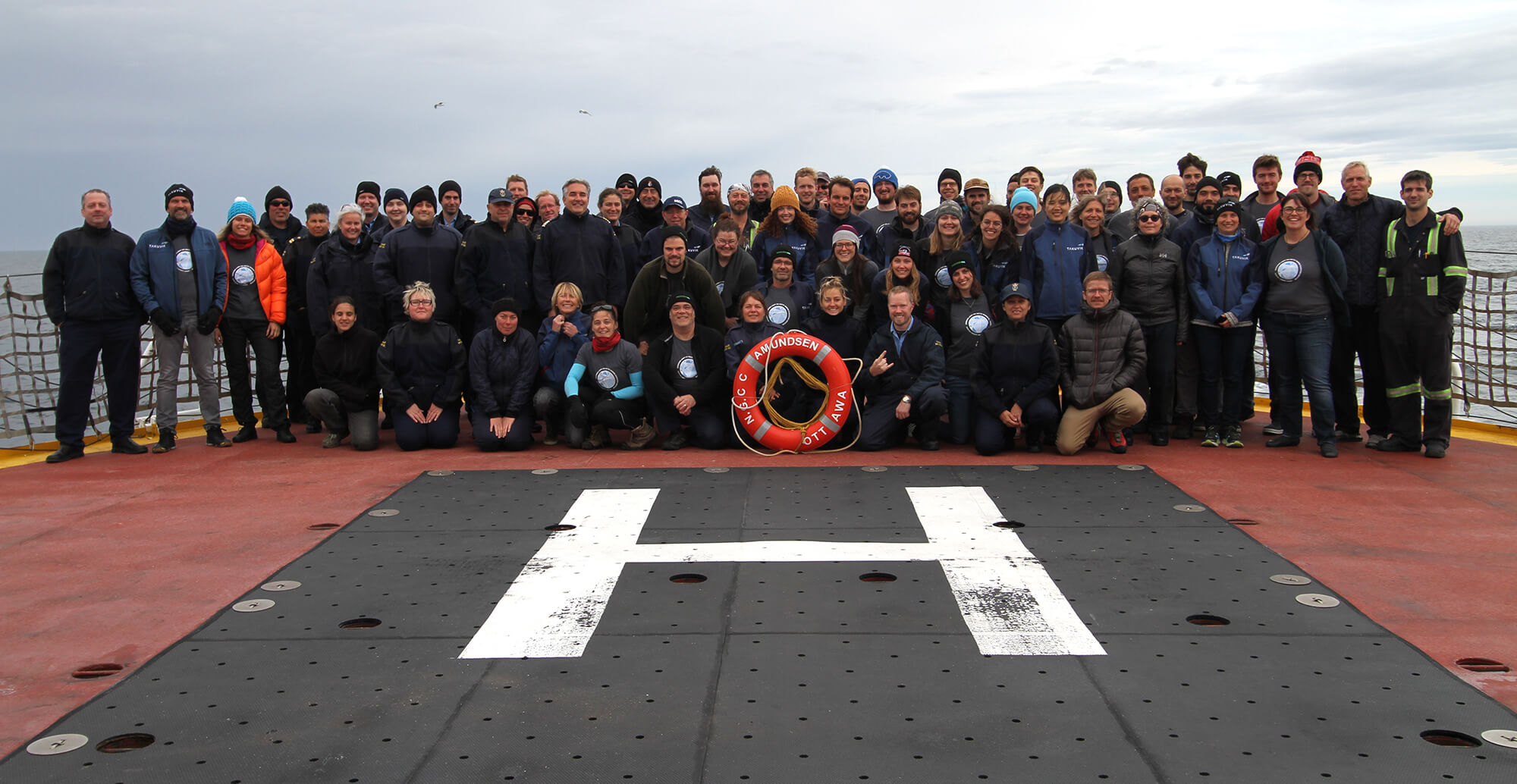
The IPS students, mentors, staff and ship crew
This last day involved data processing for each work package and preparing presentations for our fellow classmates. We reflected on the time we spent on the ice and in the lab learning about light in ice and its interaction with the biota.
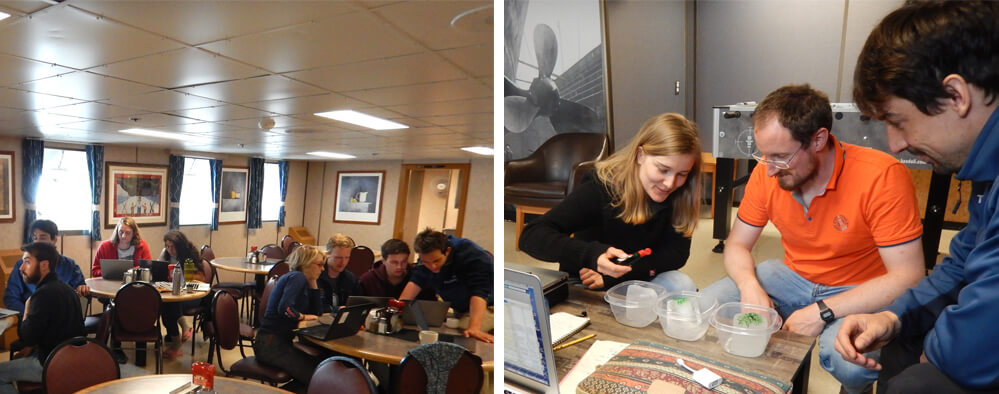
Hard at work / playing with ice and dye
Luckily, our day was not just spent at our computers. We had the opportunity to visit the engine room of the ship. It was really impressive to see how 12 people manage every functional bit of the ship, such as the engines, water, waste and repairs. Though many of the buttons were tempting, we were not allowed to touch anything.
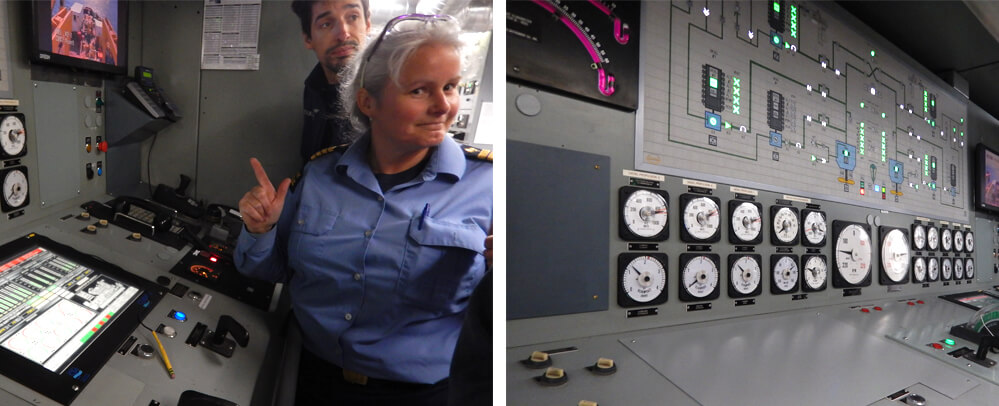
The Amundsen engine room - Lots of tempting buttons
All in all, this has been an amazing experience. Both the mentors and other students involved in the IPS 2018 created a professional, creative and productive learning environment in which people were pushed out of their comfort zone to progress in their learning. We will miss the Amundsen, its crew and the beautiful Arctic environment, which has become our home over the past 12 days. A heartfelt thank you to Sentinel North for making this possible for us.
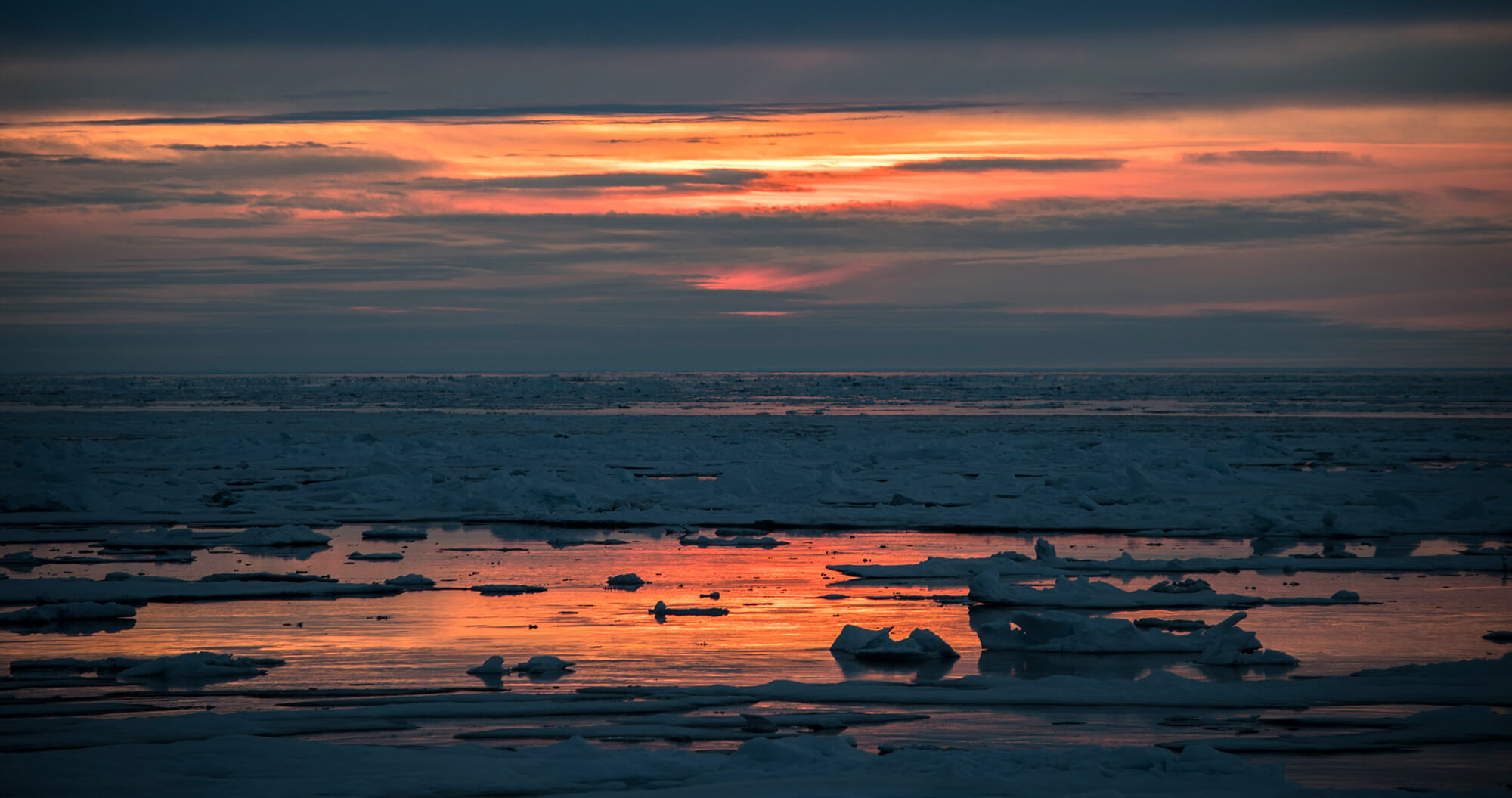
For one last time, we were gifted with a beautiful evening sky (photo: E. Cimoli)
Day 11 - Coronation Fjord
July 22 - Bjorn Andersson, Maxime Benoit-Gagné, Philipp Anhaus
Yesterday we noticed that many small icebergs were floating around the vessel and wondered where they came from. We got the answer this morning as we reached the head of Coronation Fjord, where a majestic glacier stood right in front of us, with its tongue reaching far into the sea. Big chunks of ice detach from it and become the icebergs we saw yesterday, a phenomenon called calving. We also learned that since the water in the glaciers comes from the land, it is drinkable fresh water, in contrast with sea ice. From time to time, the inhabitants of Qikiqtarjuaq still use icebergs as a source of drinking water. Rumours on the ship also say that this is the best tea water in the world, but unfortunately, we did not have time to taste it for ourselves.
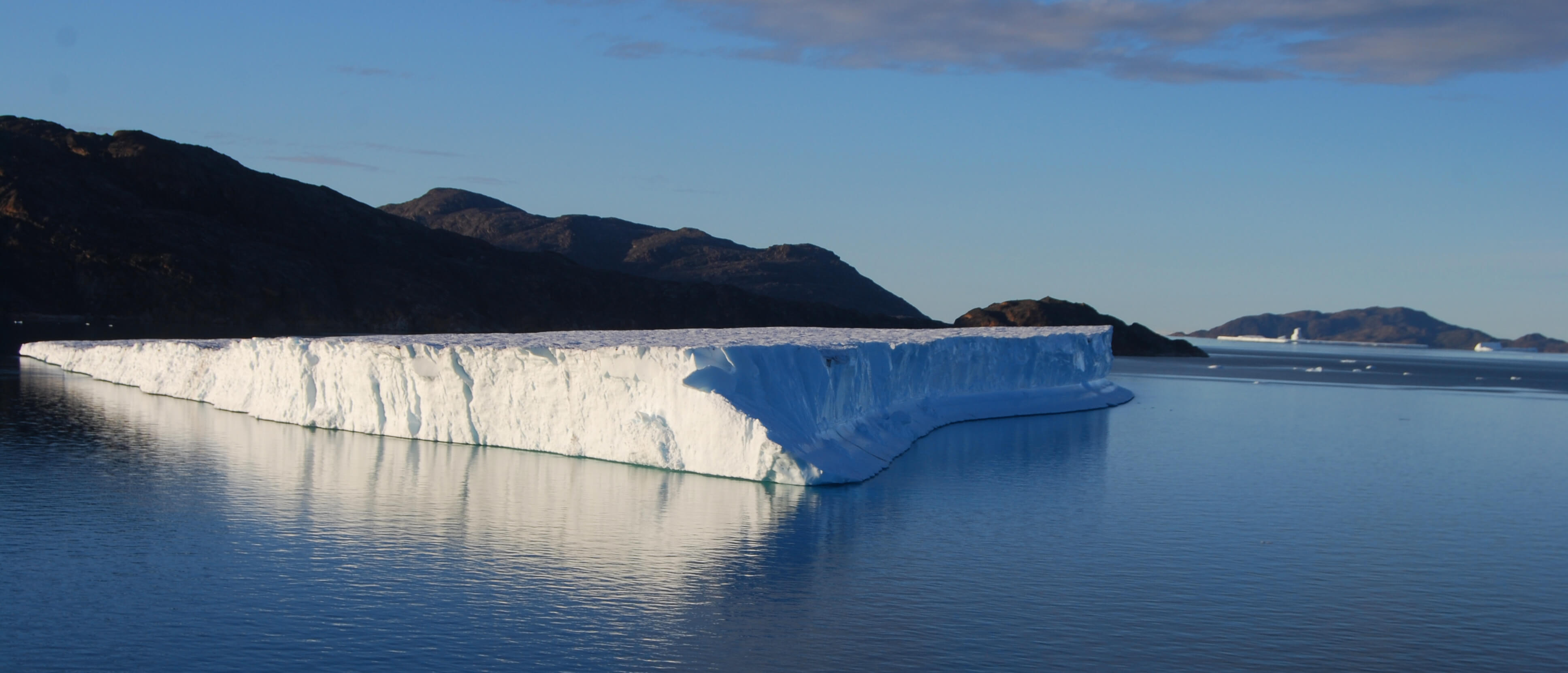
Iceberg slowly drifting out of the fjord carrying fresh water into Baffin Bay
Time is running out for us on the Amundsen and today was our last day of active scientific sampling. We needed to leave by 10 am today to make it back to Iqaluit on time. Work started early but by now the teams had found their rhythm and we completed the sampling much quicker than the previous days.
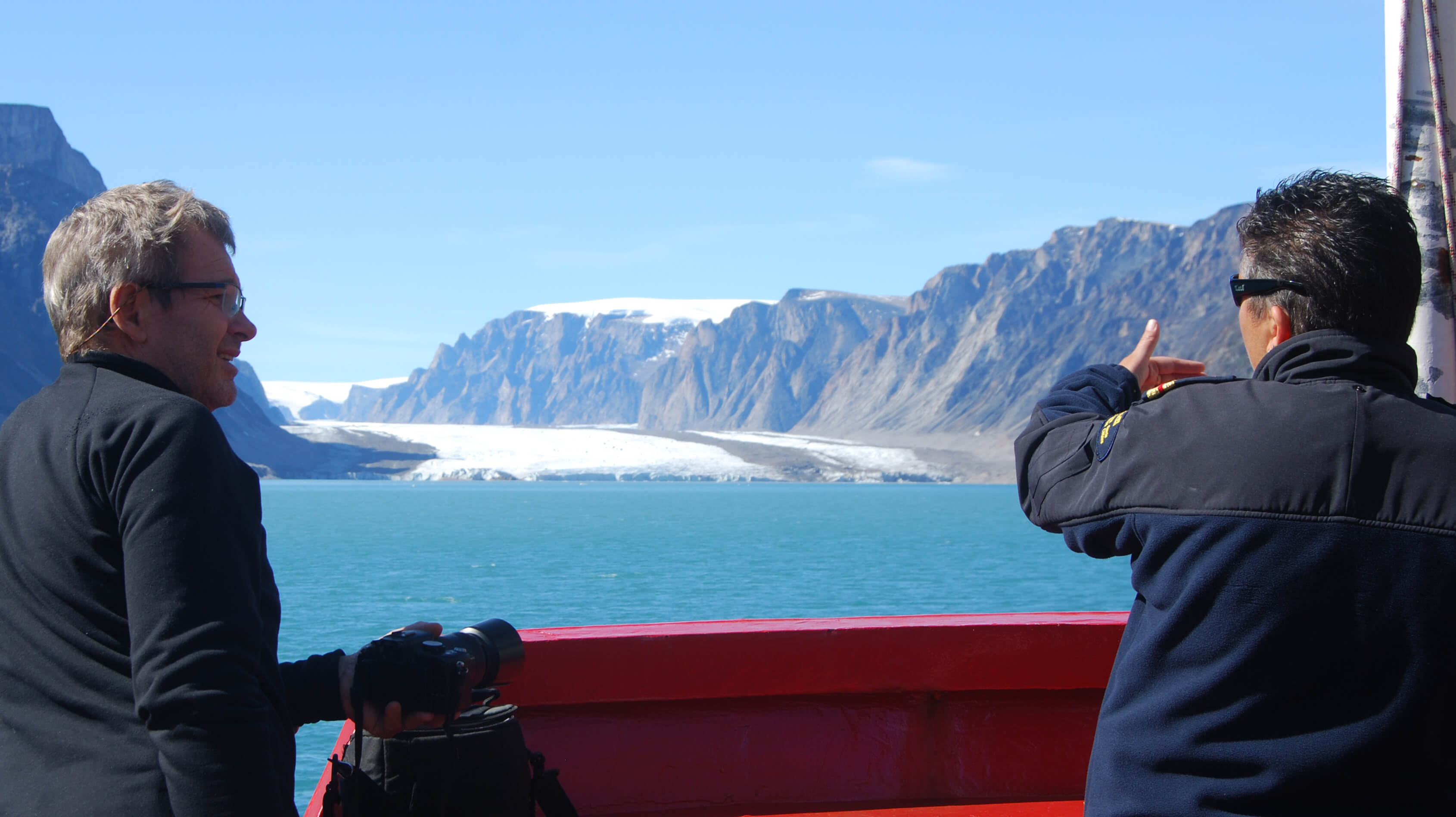
Mentor Marc Picheral discussing glacier features with a coast guard officer
After a closer view of the glacier we turned around and headed back out of the fjord. In the evening we enjoyed a celebratory dinner made up of a smorgasbord of delicious food. The chefs really know how to feed 80 sailors great food even after 11 days at sea. For those of us who crossed the Arctic Circle for the first time, there was a ceremony with diplomas and a speech by the captain himself. Tomorrow we will be in transit all day and likely cross back into the southern side of the Arctic Circle on our way back home.
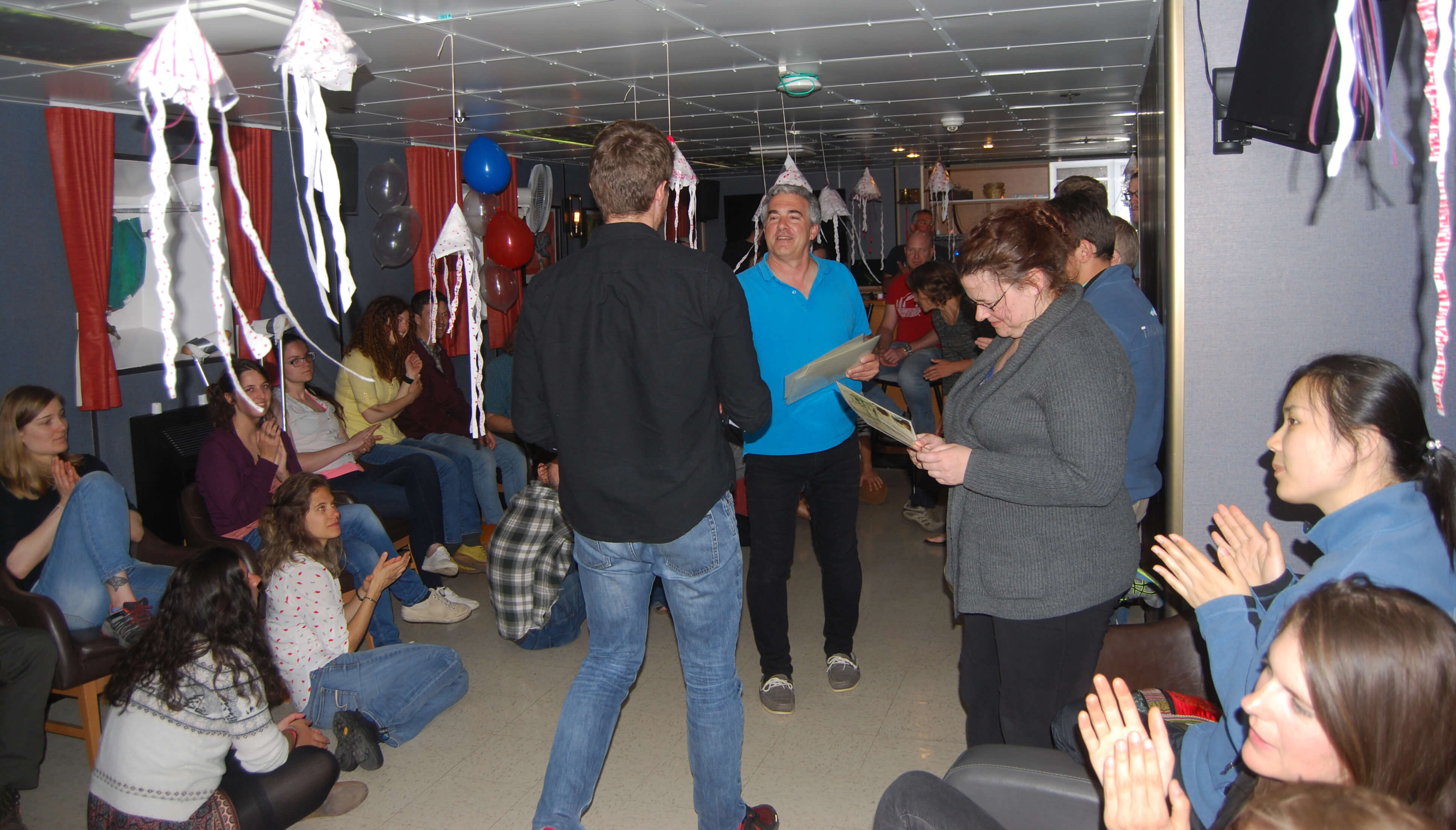
Carrying on an old maritime tradition, the Captain himself handed out a diploma to everyone on board the ship for whom this was the first crossing of the Arctic Circle
Day 10 - A healthy dose of risk
July 21 - Julek Chawarski (on behalf of his team, Christophe Perron and Sébastien Guérin)
As marine scientists trying to answer complex questions about the ocean and its changes, we spend considerable portions of our time obtaining funding and planning fieldwork to various research platforms. To central latitudes and temperate waters, we can deploy our scientific instruments from mooring platforms, drifting buoys, large and small research vessels, and even fishing boats. But in the Arctic, the combination of inaccessibility, unpredictable conditions, and high operational costs can inhibit data collection, thus hindering our complete understanding of Arctic marine systems.
Here in the Davis Strait, thanks to the Amundsen, we have the privilege to deploy small craft, such as barges and zodiacs, to maneuver safely through calm, yet ice-ridden waters. Whether studying tiny phytoplankton or the behavior of large zooplankton and fish, a small platform reduces our impact on the ecosystem and changes our perspective of what’s happening above and below the water.
Today, during the deployment of the barge, we listened as our gregarious leader, Emmanuel Boss, shared his knowledge of field instrumentation and gave us advice on how to be a successful field scientist. What we distilled from our various conversations is that early career researchers should strive to balance diligence and passion with a healthy dose of risk-taking.
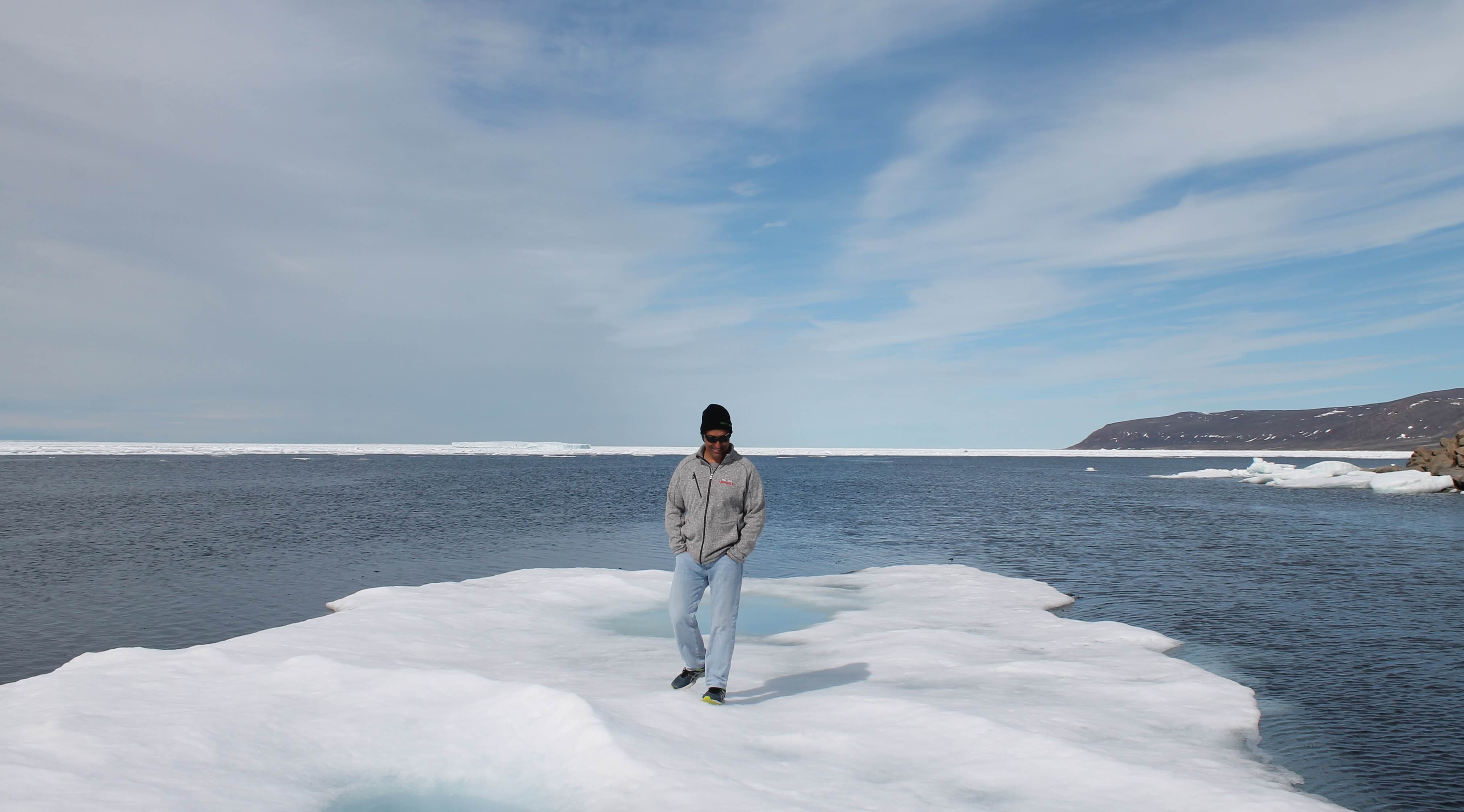
Part of taking risks involves having fun on the sea ice. Emmanuel walks across the ice, testing before I step onto the grounded ice flow. (photo: J. Chawarski)
Later on, he handed us his smartphone so we could test an application developed by one of his students, conceived to measure solar irradiance of the sea surface. Prototypes like this one, which use advanced, but omnipresent technology in our pockets, can transform the field of oceanography in a meaningful way. Emmanuel’s excitement about innovation is immediately infectious. It’s easy to imagine a lobsterman hauling traps, pausing to snap a few pics of the sea surface and sky, immediately narrowing down the void between how we get our food and the science to explain how that might change in the next century.
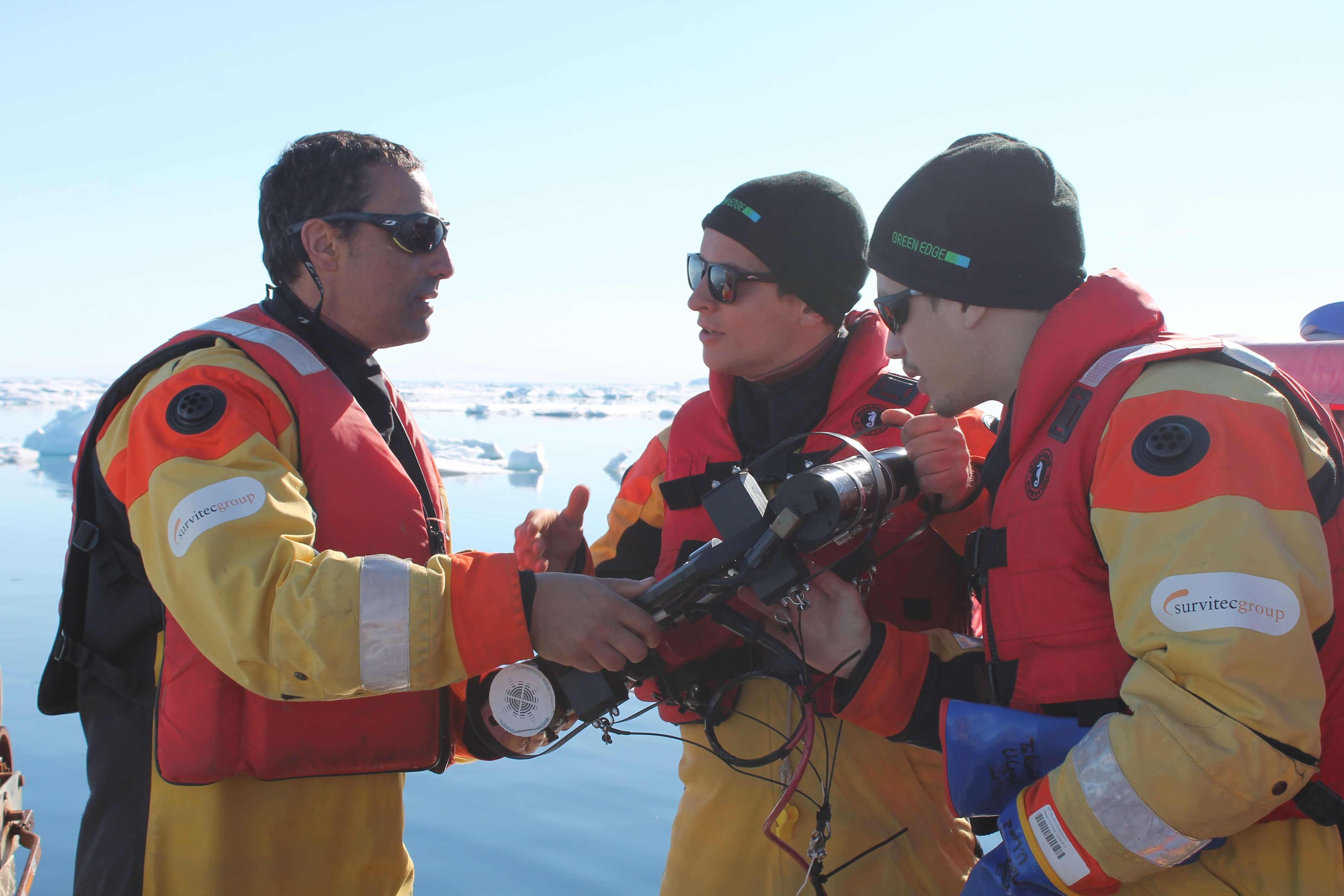
Sebastien asks Emmanuel, “Does this thing go to 11?” (photo: J. Chawarski)
Back on the Amundsen, we scanned the horizon for icebergs while various instruments were taking calibration measurements. We took time to appreciate how fortunate we are to work in such a beautiful and pristine marine environment, as we entered the majestic fjords of Baffin Island, our sampling station for tomorrow.

Entering the gorgeous fjords of Baffin Island (photo: M-F. Gévry)
Day 9 - Discovering Qikiqtarjuaq and its people
July 20 - Marc-Antoine Bansept, Juan Li, Gwenaëlle Gremion
We were about 60 to disembark to Qikiqtarjuaq, a small community of 600 people, of which half are children. The day started around 10 at the Gathering Center, where William and Alisha greeted us and invited us to visit the museum to learn about the local culture. Then, Dany and Adrian guided us to the Inukshuk hill where we enjoyed a lunch with a beautiful view of the bay and the village.
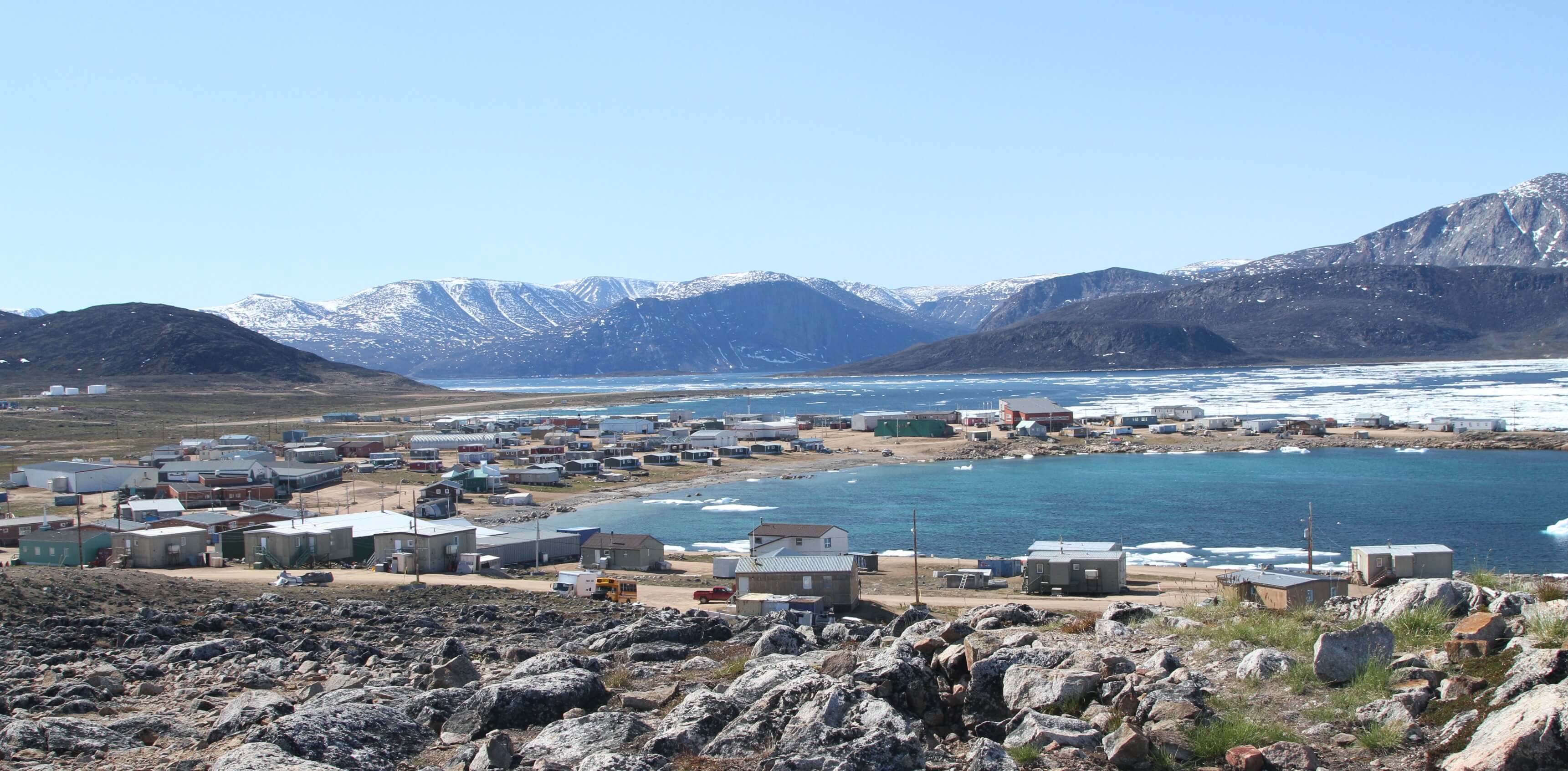
The bay and village of Qikiqtarjuaq (photo: M-F. Gévry)
In the afternoon, we were invited to a welcoming ceremony organized for us by William and Geela (the senior administrator). We tested our ability in the Inuit game of “1 foot and 2 feet kick”, and some of us did pretty well! Ann and Leila performed throat singing which, in its traditional form, has two singers facing each other and trying to make each other laugh.
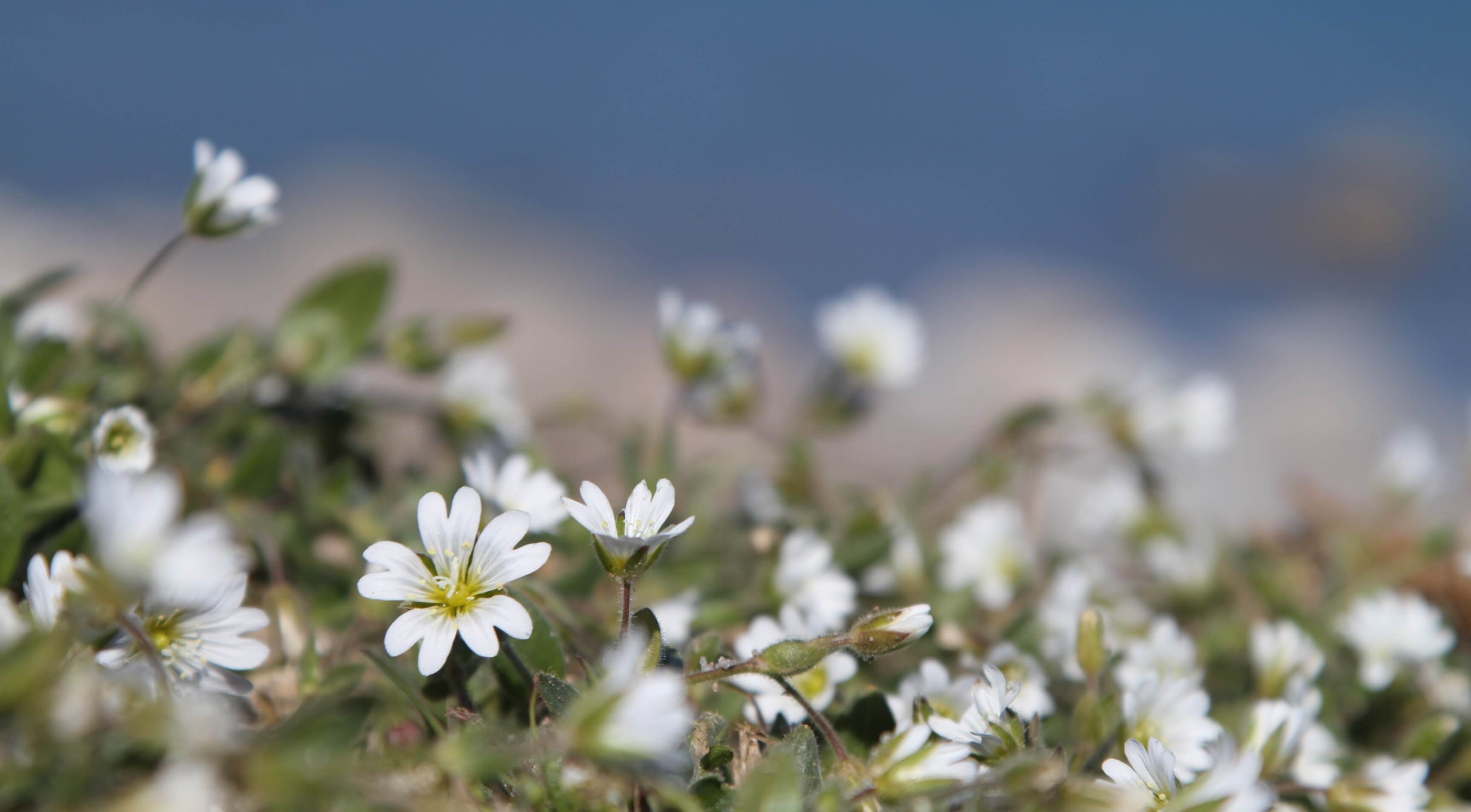
Flowers in Qikiqtarjuaq (photo: M-F. Gévry)
Our immersion in Inuit culture continued with a feast of polar bear meat, raw and cooked seal, dry arctic char and bannick (yeast-less bread). While we were enjoying the meal, seven of us could not resist doing an arctic swim between ice blocks of the beach. To conclude the day, we had the chance to walk around the hamlet, talking to people, and playing with the kids.
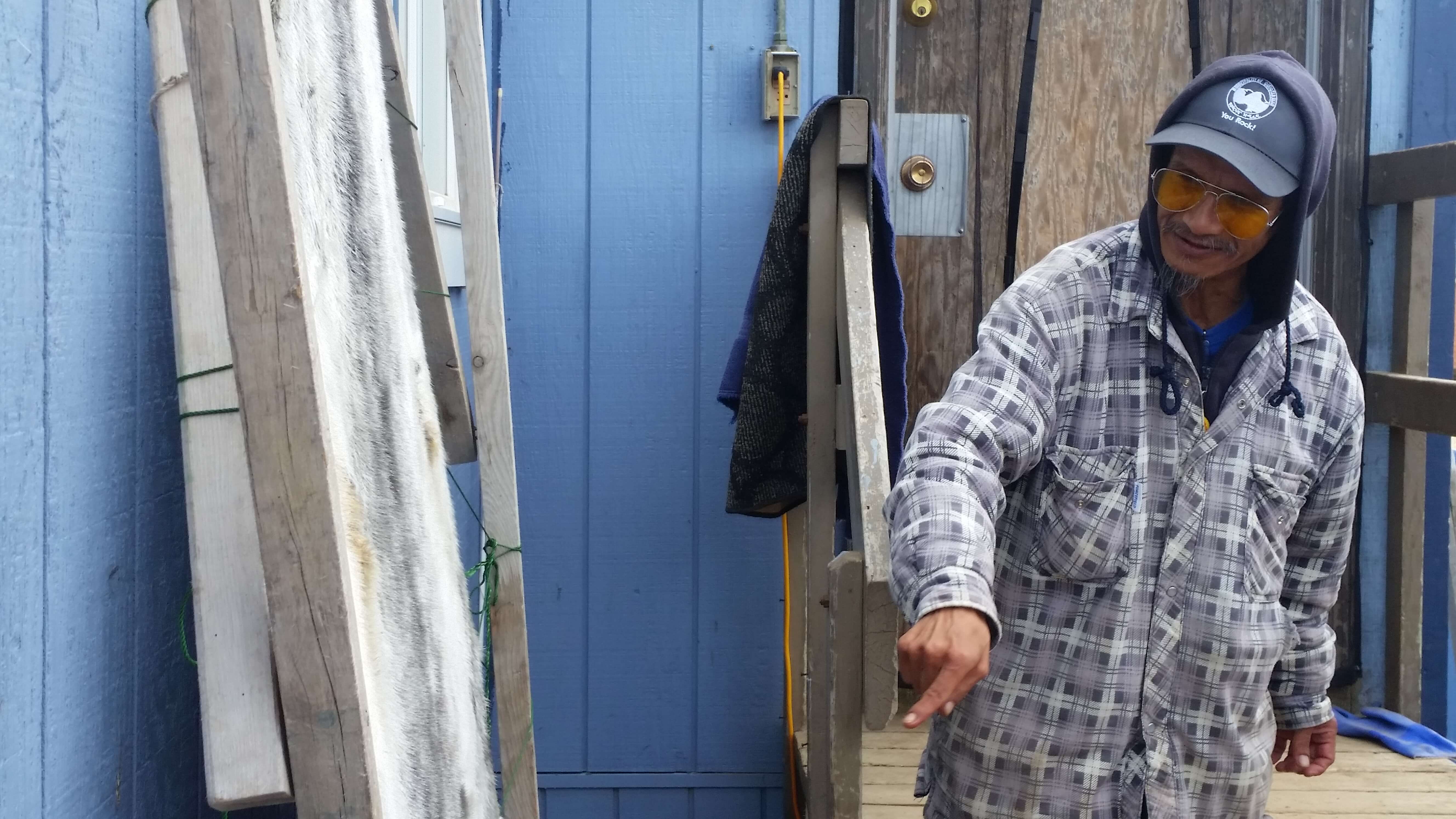
Our guide Danny Audlakiak showing a seal hide (photo: G. Gremion)
The time to get back on the ship came all too soon, although we all felt rich from this unique experience. The simplicity of the people living here is admirable, despite the difficulties that some people are experiencing living in a remote community. This includes health issues in the aftermath of a tuberculosis outbreak and food security due to climate and social changes. In the end, it was extremely humbling to receive such a warm welcome and to see the positive and open attitude of these people towards scientific work being done in this region following the outreach effort of the Green Edge project.
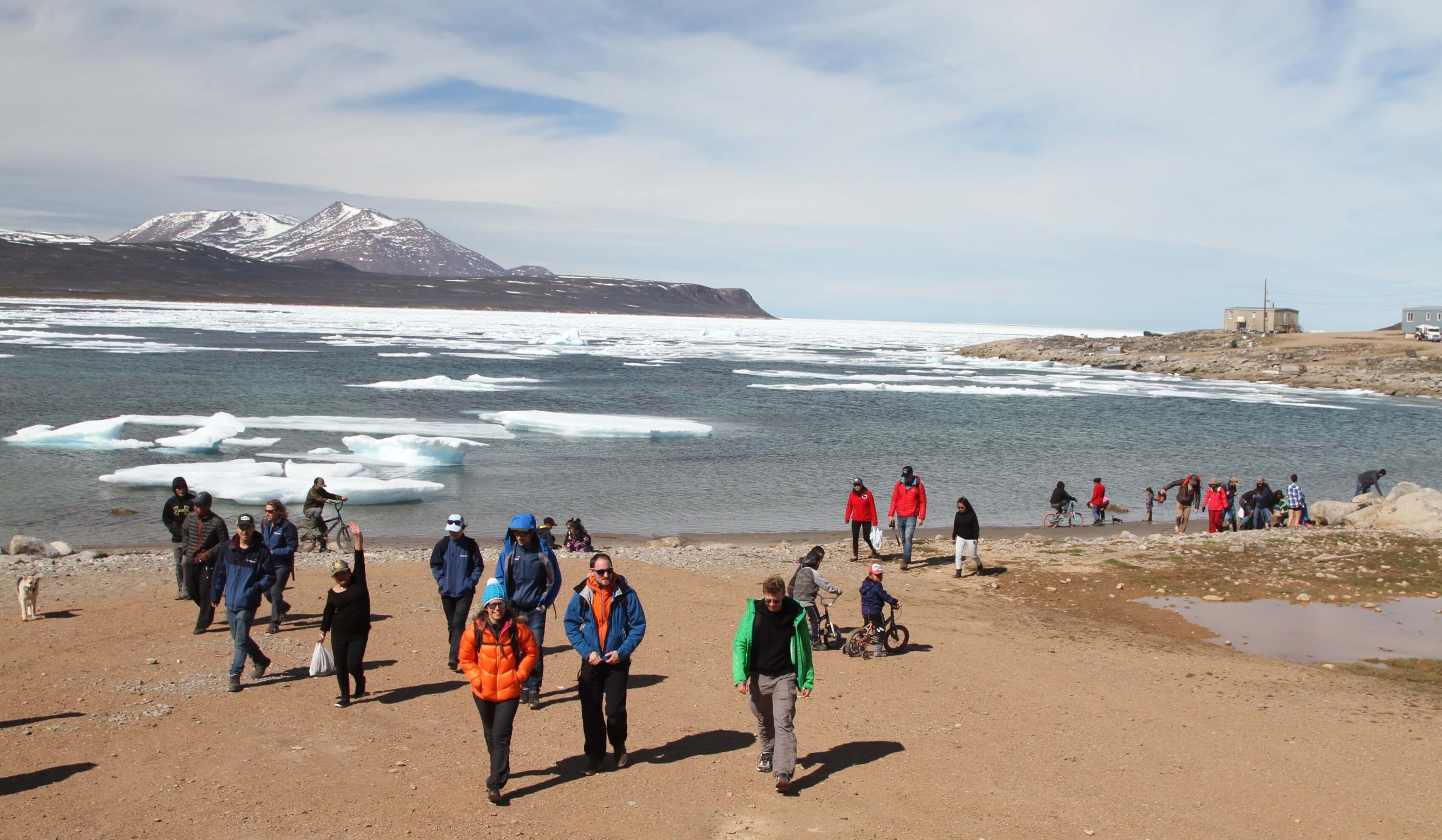
Walking on the beach of Qikiqtarjuaq (photo: M-F. Gévry)
Day 8 - visitors on board
July 19 - Julek Chawarski, Sébastien Guérin, Christophe Perron
After slowly navigating through a thick and stiff sea ice cover during the night, we arrived in the bay of Qikiqtarjuaq in the morning.
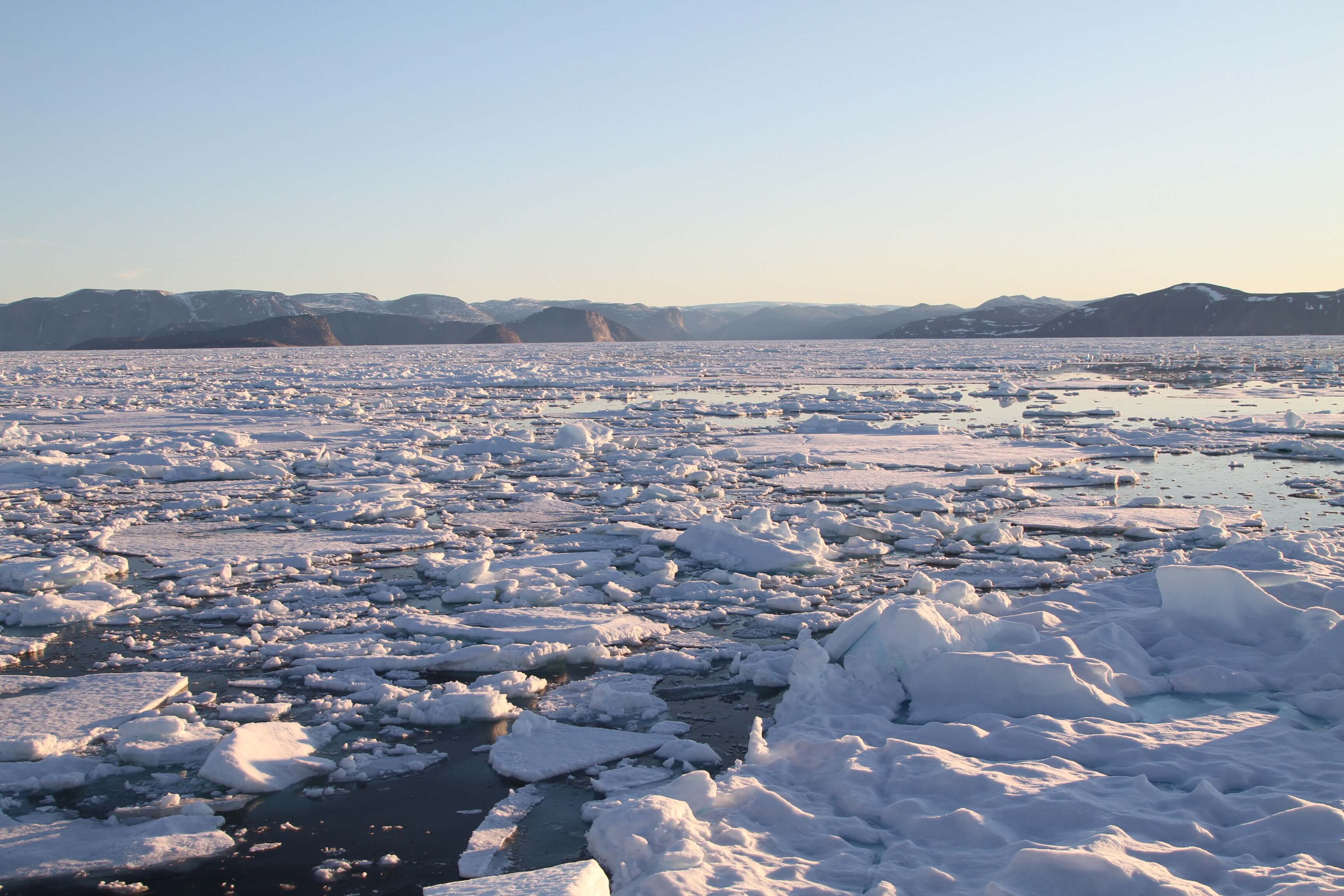
A view of the sea ice the night before arriving in the bay (photo: M-F. Gévry)
After a few days of cold and windy climate, we were surprised to be able to work on the deck in t-shirt! Today’s temperature was sunny and calm and there was not a single wave. The sea appeared as a mirror reflecting the beautiful mountains surrounding us. The bay’s breathtaking scenery forced all of us to go outside and take some time to wonder.
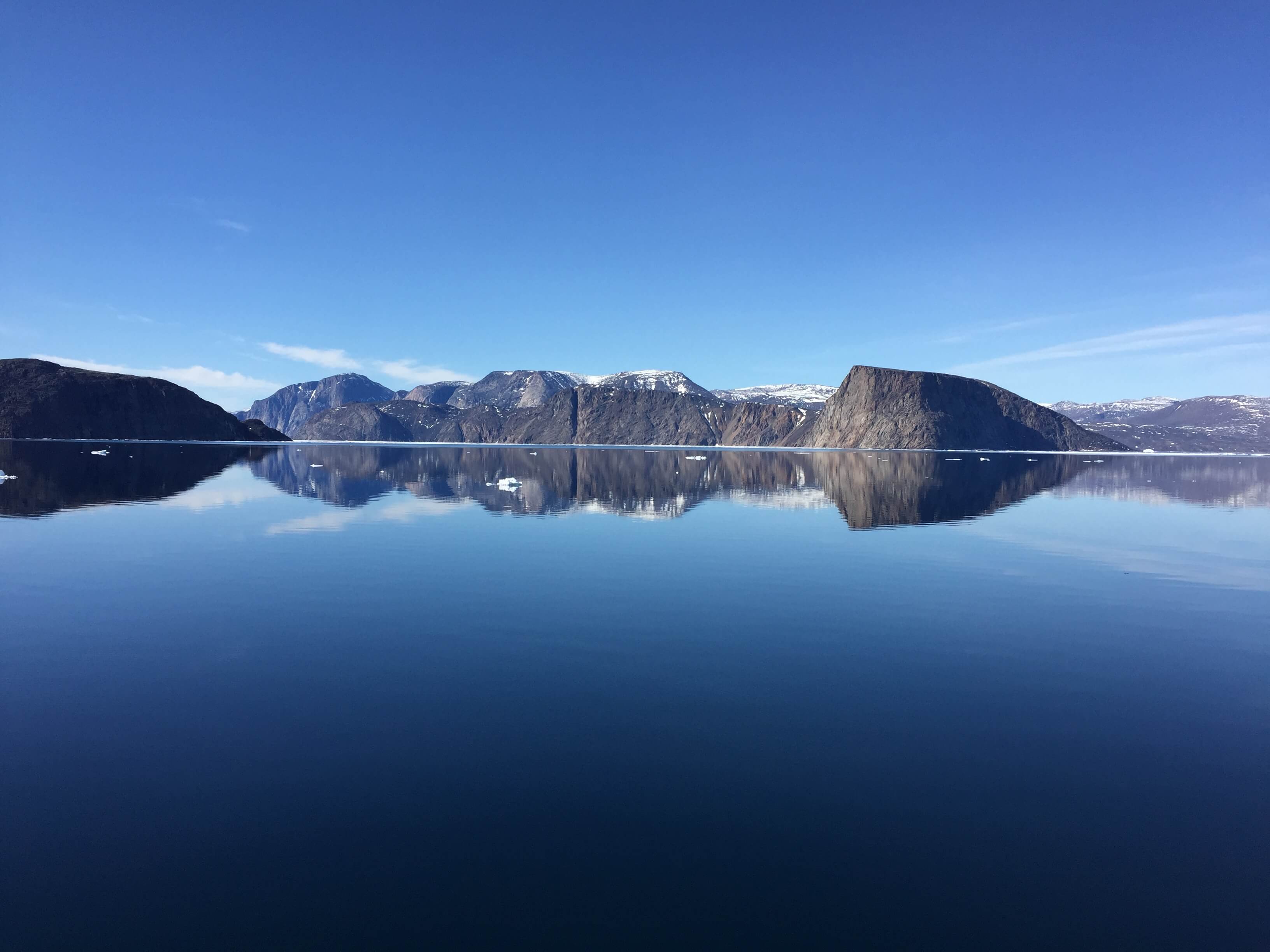
We were astonished by the calm sea and the mountains surrounding Qikiqtarjuaq
On this beautiful Thursday, we had the chance to receive some special guests. Nine members of the Qikiqtarjuaq community joined us on board for a tour of the ship and a brief introduction to all the scientific instruments. We were very happy to share with them and got even more excited to discover their way, which we will be doing tomorrow during an expedition to Qikiqtarjuaq. There, we hope to learn more about the services that the ocean provides to this community.
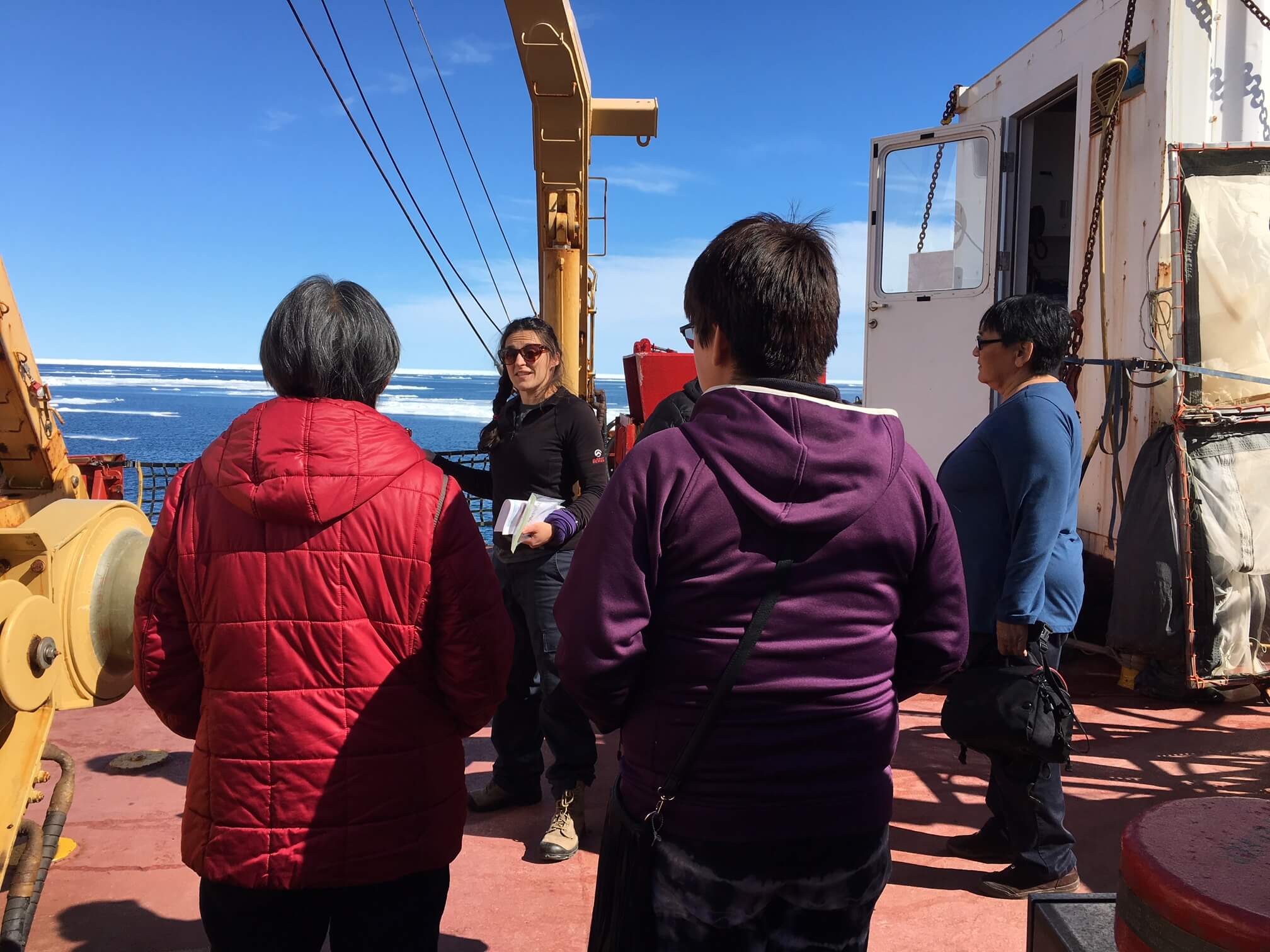
Joannie Ferland explaining how the nets are deployed with the crane to sample zooplankton
While our visitors where on board, some mentors and students had the chance to go on the barge to deploy a glider (controlled buoy). This glider loaded with all kinds of sensors is used to better understand the physical and biogeochemical properties of the water mass. The glider was successfully recovered after making many vertical profiles across the bay.
In the evening, we listened to Emmanuel Boss giving us some precious advice regarding our future scientific careers. His talk regrouped many tips on different topics like how to publish or how to keep healthy and constructive relationships with our mates at work. Both students and mentors really appreciated the originality of the talk. Thank you Emmanuel! It was refreshing!
Day 7 - Where light meets ice
July 18 - Maxime Wauthy, Jody Reimer, Victoria Fowler
What an amazing day for us today! The weather cleared, and we had beautiful blue skies without a single cloud in sight. We woke up surrounded by ice, and rumours of one lone polar bear somewhere on the horizon. We have been in and out of ice all day, which is such a unique experience that one can really only have on a trip like this. It really shows off the power of this ship! It is amazing to stand at the very front and look over the edge as it pushes through the ice – sometimes a few metres thick! – without seeming to take much effort.
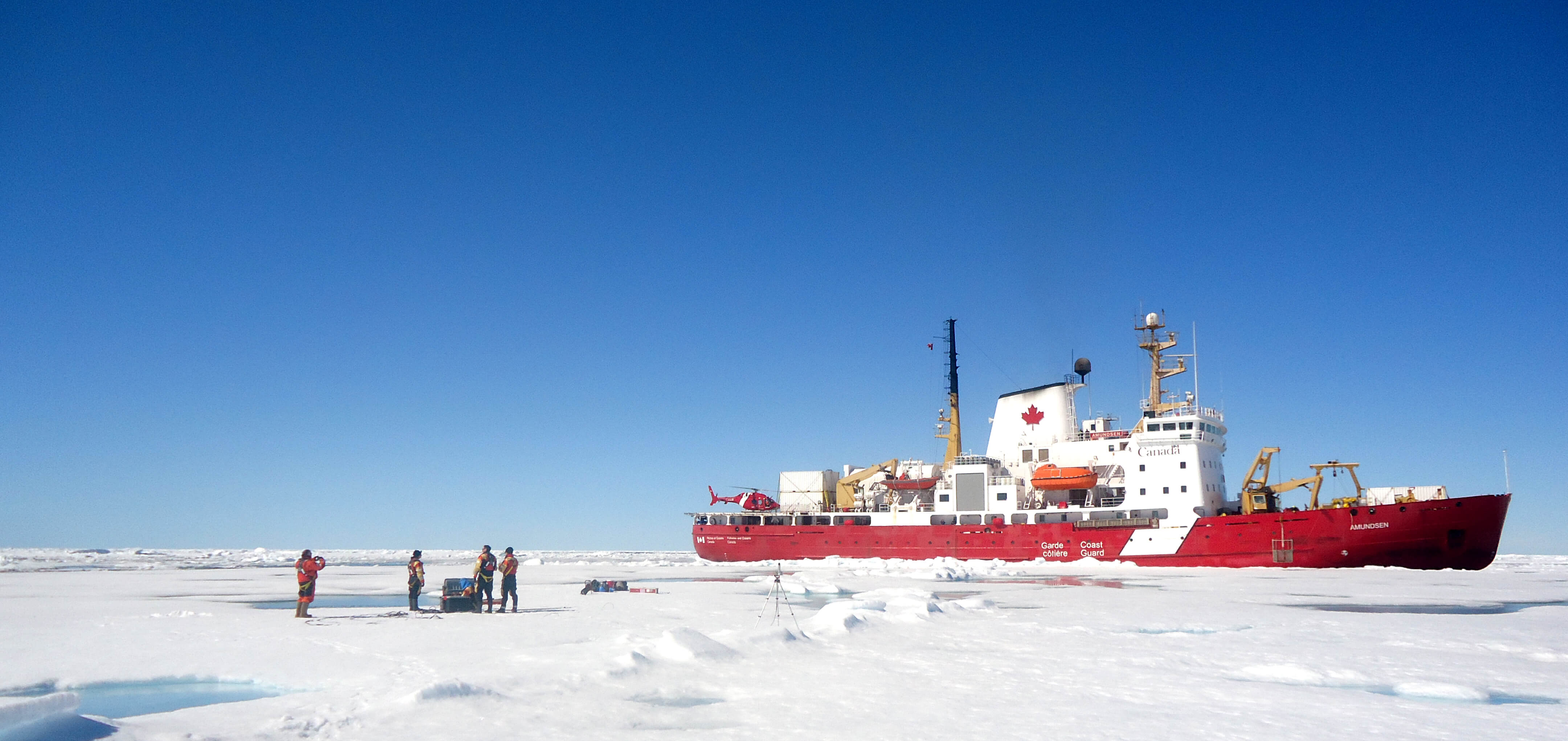
Can it get any better than this?
We got to look at this ice first hand today, as it was our group’s turn to go out on the sea ice to do the sampling. We got very lucky with the timing of this, as we had such a beautiful day! It was Vicky’s first time ever walking on ice of any kind, so she was extra excited, although were a little nervous! The ice looks deceptively unstable, but once we were walking around on a large floe we all gained confidence in its ability to support us.
Just getting to the ice proved to be a new experience for most of us, as we got lowered off the side of the ship in a cage, which allowed us to go directly from the Amundsen onto the ice. It was certainly the most scenic elevator ride of our lives.

The most scenic elevator ride you can get is in the "ice cage"
Once on the ice, we did several different things, both taking physical light measurements with sensors lowered through holes in the ice, as well as collecting some samples for the biologists. We used a new instrument which one of our mentors, Christian, had recently put together to measure albedo (the proportion of light which is reflected, compared to the light which is incoming). He assured us it was not a complicated instrument, and that “anyone can do it, even a child”. Being a team of biologists, we were not convinced that our instrumentation skills were quite up to his level, but it was fun to try it out nonetheless.
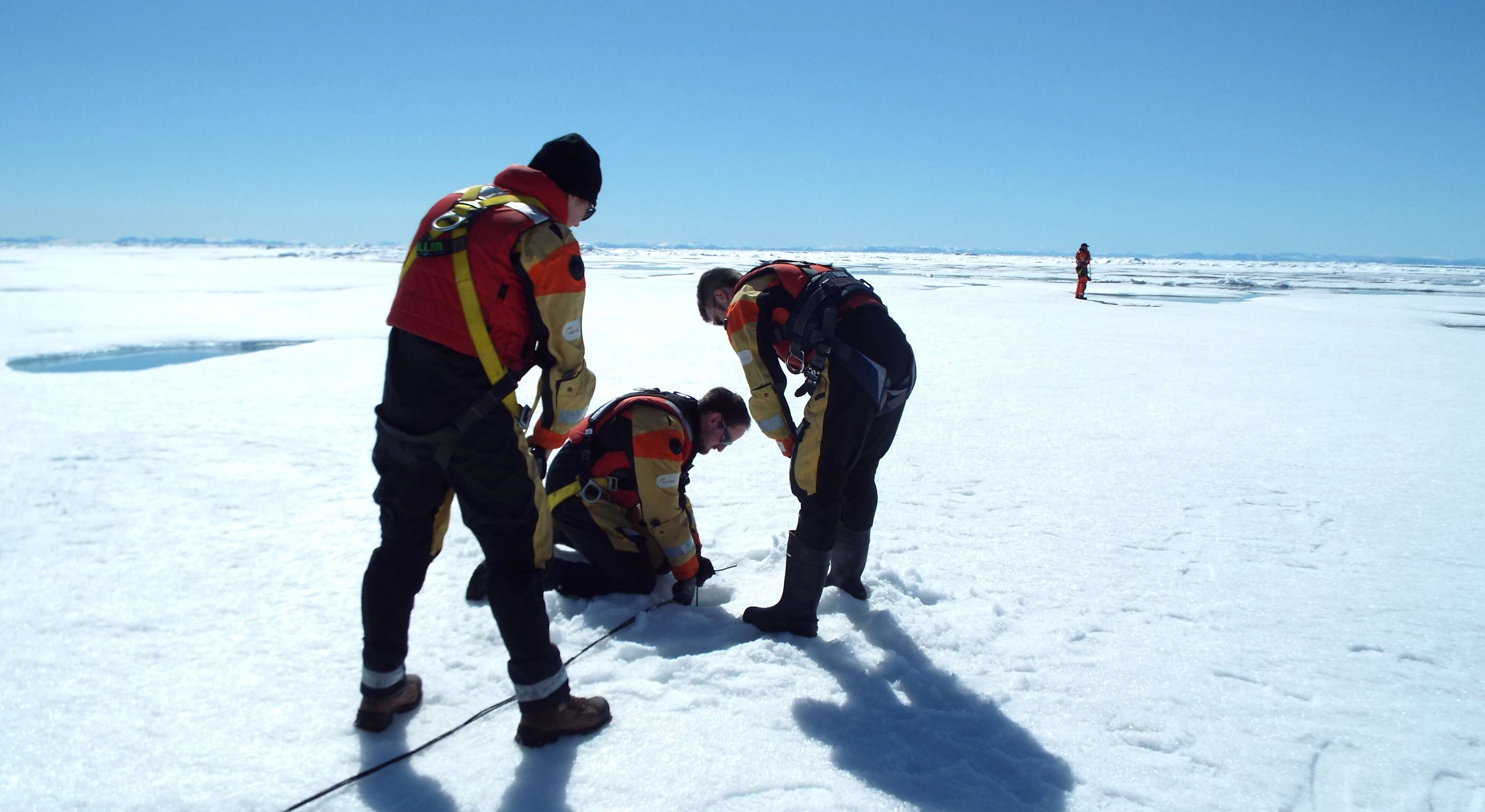
Measuring light under the ice
Tonight we had a group discussion about working in the North with local communities. There were many interesting experiences shared and it got us all looking forward to our interaction with the people of Qikiqtarjuaq over the next couple of days.
We now have an amazing sunset view as we approach Baffin Island, so we will leave you with the above as we go to enjoy it!
Day 6 - Tracking the base of the Arctic food chain
July 17 - by Geneviève Arboit, Félix Lévesque-Desrosiers, Yasmine Alikacem
Biological productivity at the base of the food web in marine Arctic waters is highly constrained by the presence of sea ice, which limits the penetration of sunlight and exchanges at the air-sea interface. Today’s goal was to gain a better knowledge of this phenomenon, and learn how to sample and analyse nutrients from the water column. To do that, we would have to measure how phytoplankton makes photosynthesis by incubating it and measuring the output, while at the same time determining the ocean’s content in carbon, nitrogen and chlorophyll A.
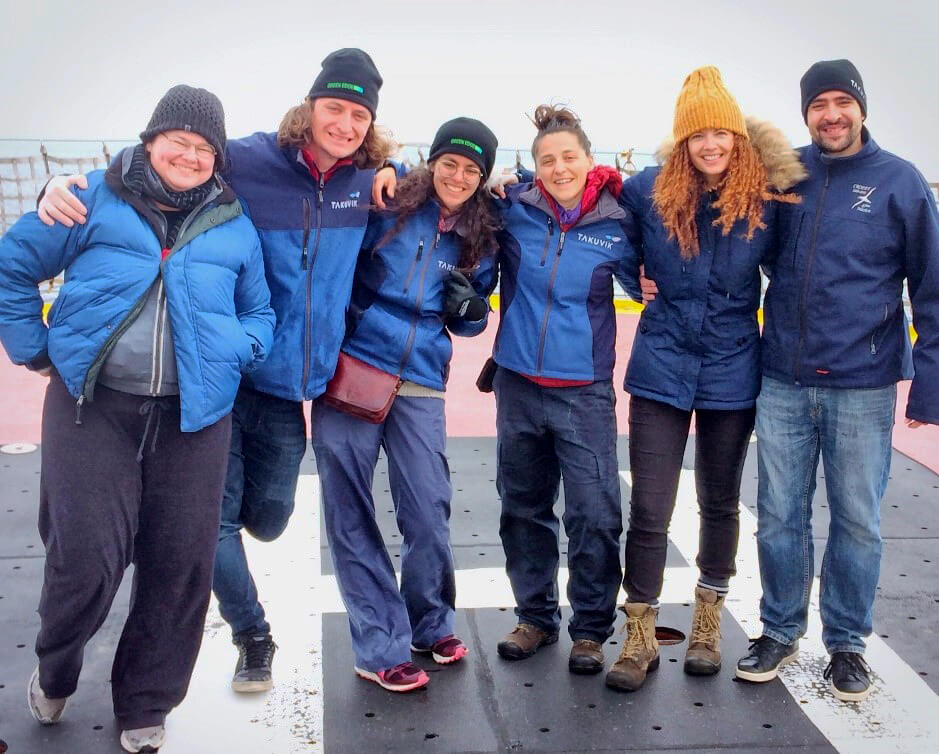
Students and mentors ready to study the Arctic food web
The first step was to measure the light profile of the water column. By doing this, we were able to choose the best depths to sample ocean life from the rosette. We collected a total of 97 litres of sea water spread on a 75 metres column in the Arctic Ocean. We first added a solution of bicarbonate enriched with Carbon-13 to 14 samples of 500 ml taken from six different depths. Each sample was then incubated into an environment imitating their conditions below the sea.
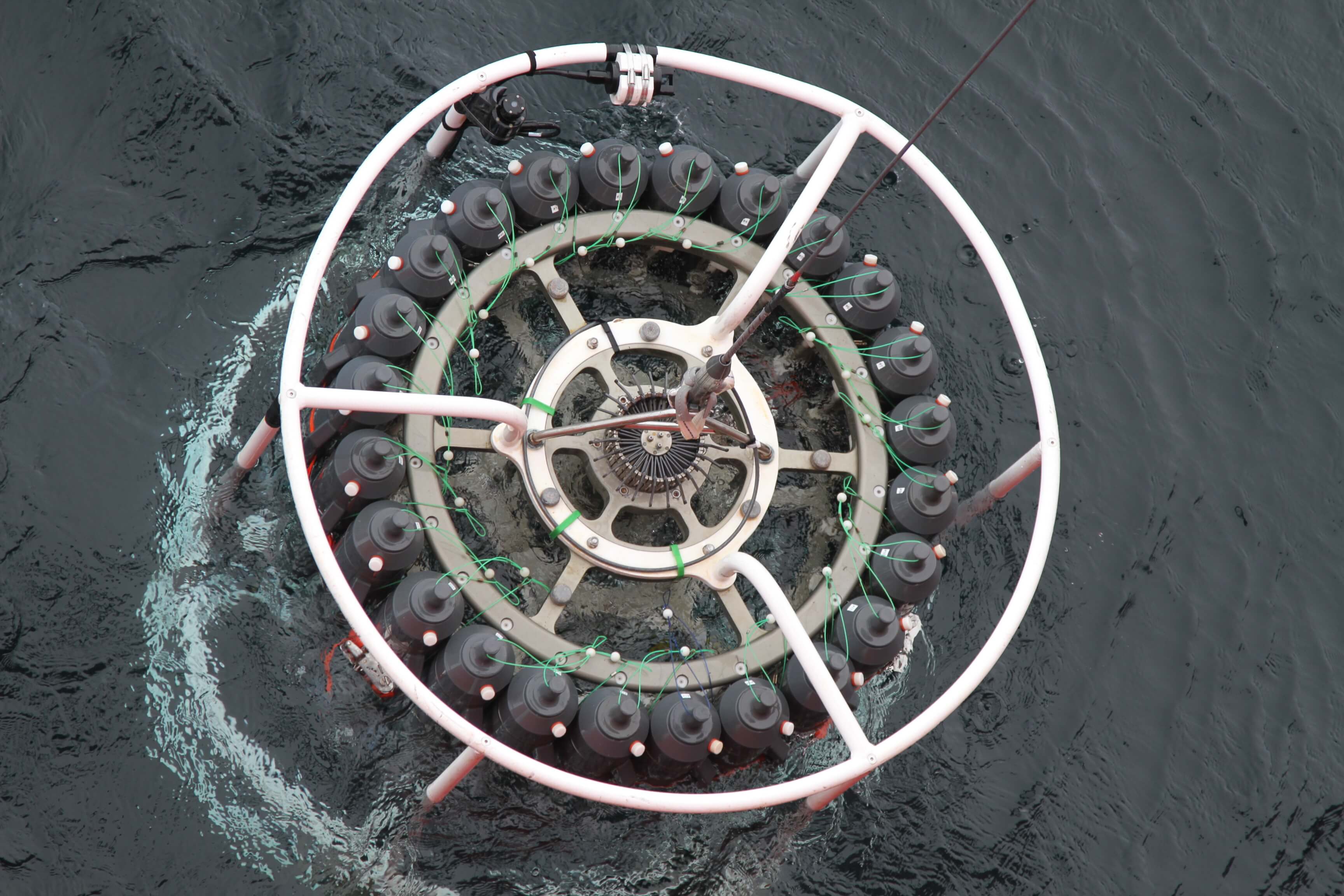
The rosette is useful for sampling nutrients in the water column
After a great seafood cassolette lunch, we filtered the remaining 90 liters for further analysis. Using fluorometry, we were able to relate chlorophyll A and pigments concentration to the biomass. Carbon and nitrogen concentrations measurements could also be determined for a better understanding of the environment.
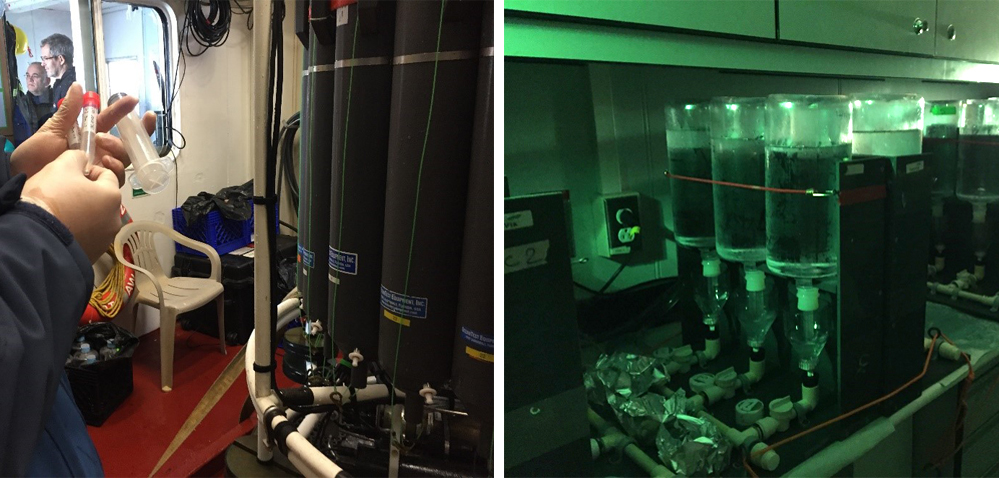
Some of the manipulations involved in water analysis
To sum up, by looking at primary production, (especially carbon, nitrogen and pigments), we gathered data that allows us to determine the base of the food web by looking closely into the station’s primary producers, namely phytoplankton.
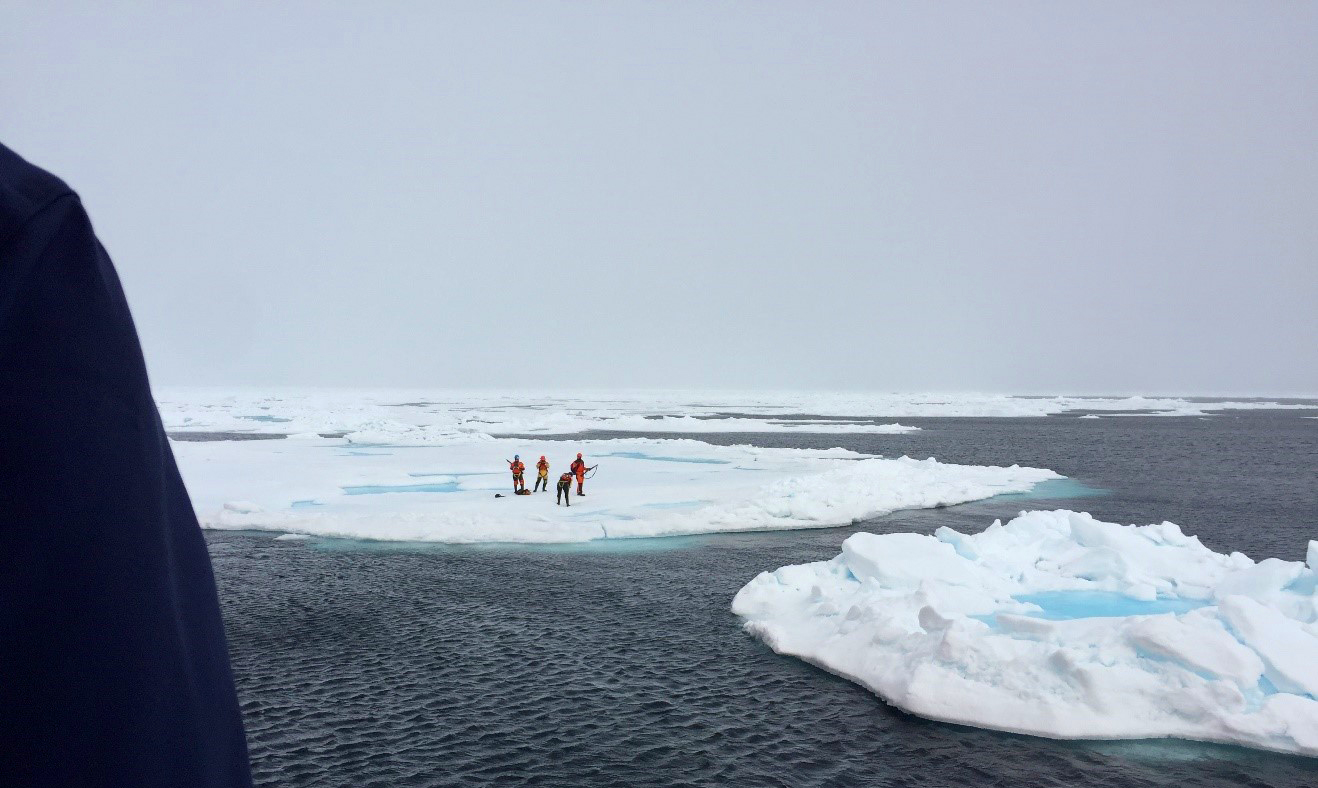
While waiting for the filtration to finish, we observed fellow scientists taking measurements on the ice
Day 5 - The Scientific Quest
July 16 - by Bjorn Andersson, Maxime Benoit-Gagné, Philipp Anhaus
Today was a very early (3 AM!) awakening on the CCGS Amundsen. The mission was to recover an overwintering ARGO float with lots of valuable scientific equipment and unique data. Luckily, because we entered the Arctic Circle yesterday, there was enough daylight for fellow Ph.D. student Gwen to spot the float stuck in pack-ice. Great job Gwen!
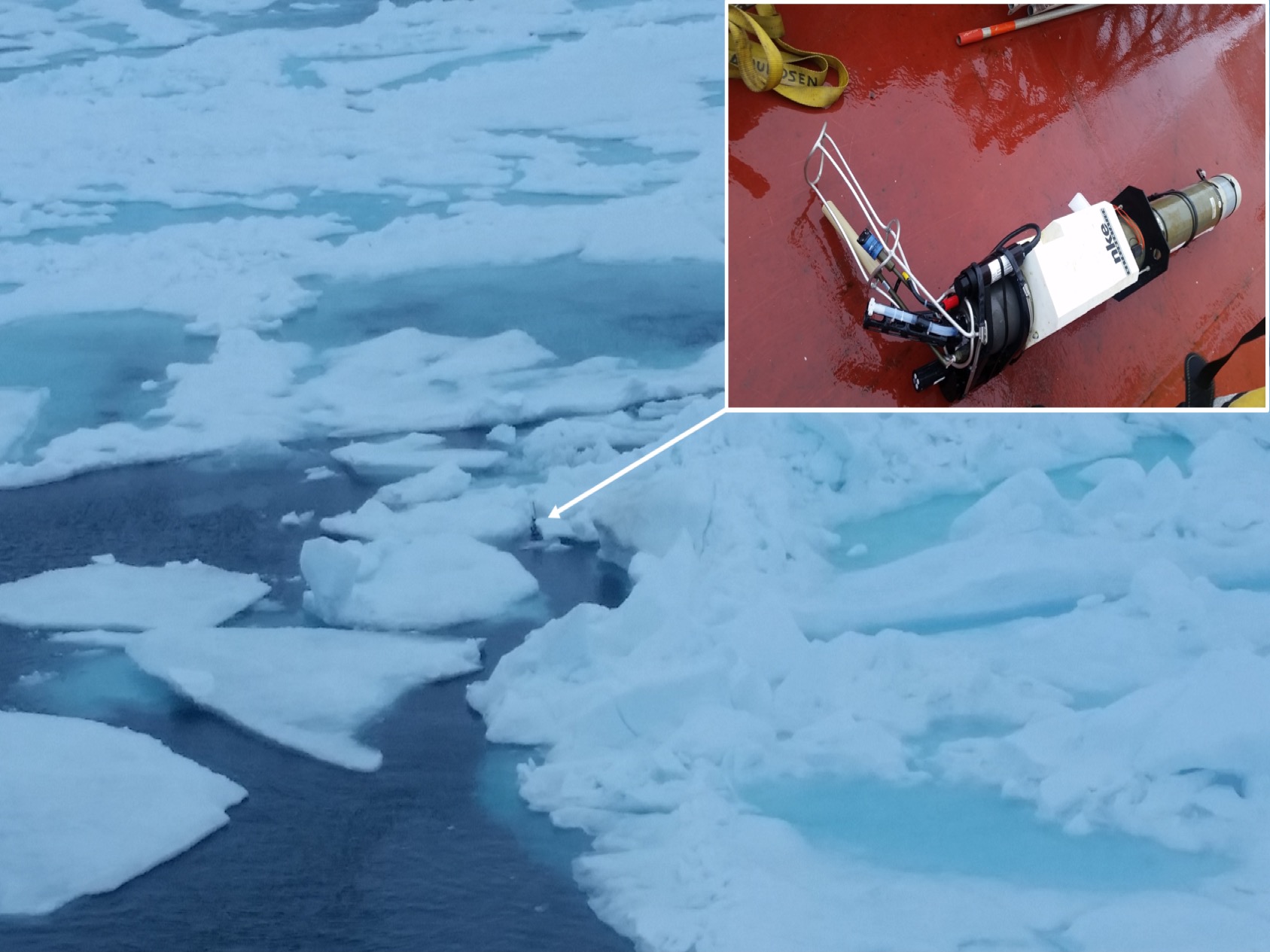
Would you have spotted this ARGO float stuck in ice all winter long?
The rest of the crew woke up to a grey day with near zero-degree temperatures, drizzles of rain, and increasing wind speed. Today was also the day we reached the first sampling station and could begin the field work for which we travelled by plane, helicopter, and boat during the past four days. The group of 40 scientists split into six smaller work groups that set out to investigate different aspects of the Arctic ecosystem and the physical properties of its water. This involved sending probes, nets, and water collectors down to depths of more than 200 meters. Some of us also investigated how sea ice (which at our current location still covers up a significant portion of the ocean surface) affects the quantity of light that enters the ocean, or reflects it back into space. This is an important thing to understand because light affects primary production and global warming.
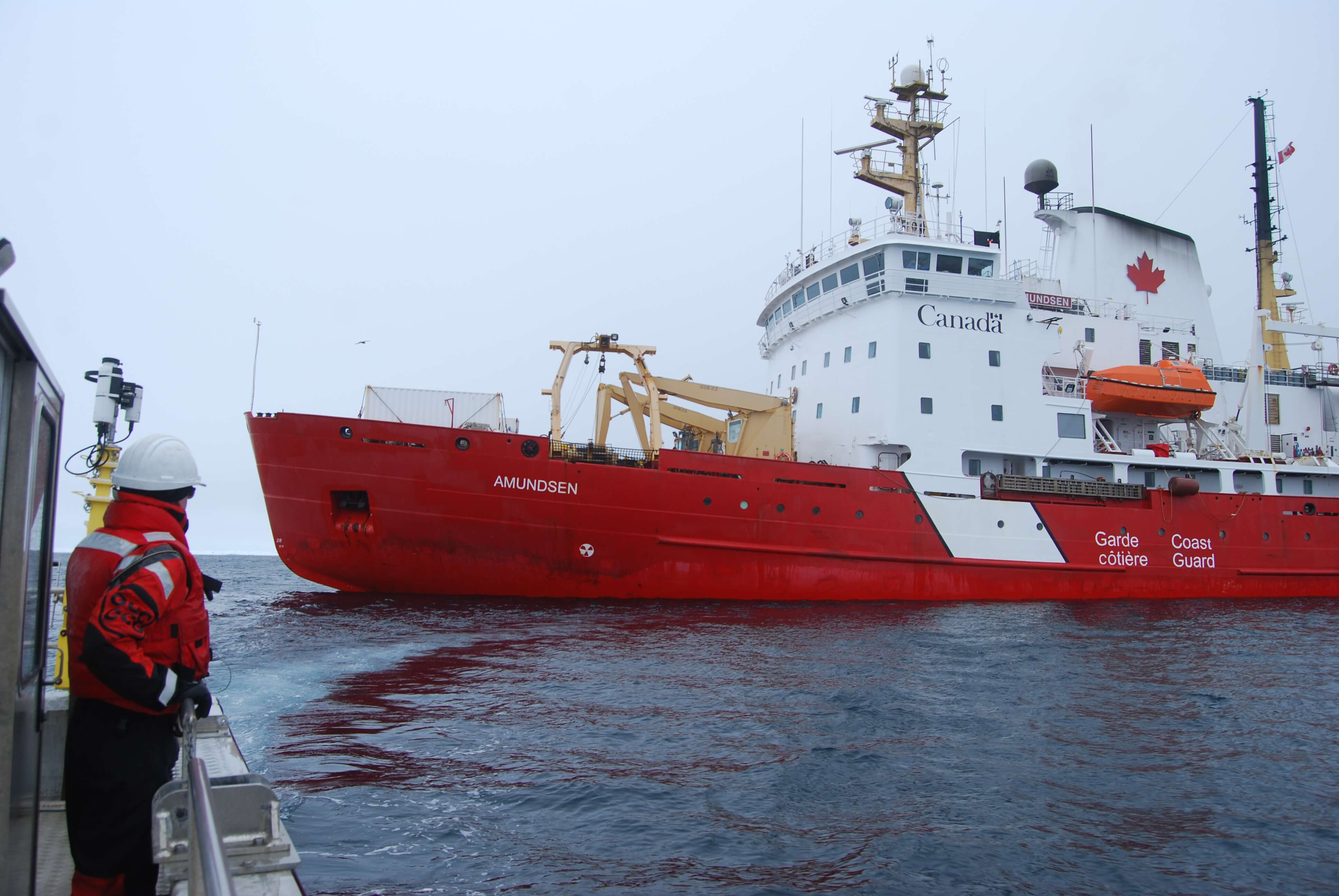
The Amundsen seen from the departing barge
Our specific group was interested in understanding what happens to the light that does enter the ocean. We first had to get away from the large shadow cast by the Amundsen, which we did by boarding a smaller, 10-meter boat. This was the first time we ventured nearby the icy waters and realised how cold the Arctic can be even during the summer. We deployed sensors that detected small variations in light intensity and color shifts associated with increasing depth. Among other things, this provided information about the abundance of microscopic algae, how far down they are able to grow, and what happens to them when they die. We also measured properties such as salinity, temperature (-1 °C), pressure, and oxygen concentration, which act like fingerprints, telling us where the waters came from, how they mix together, and – potentially - where they are going.
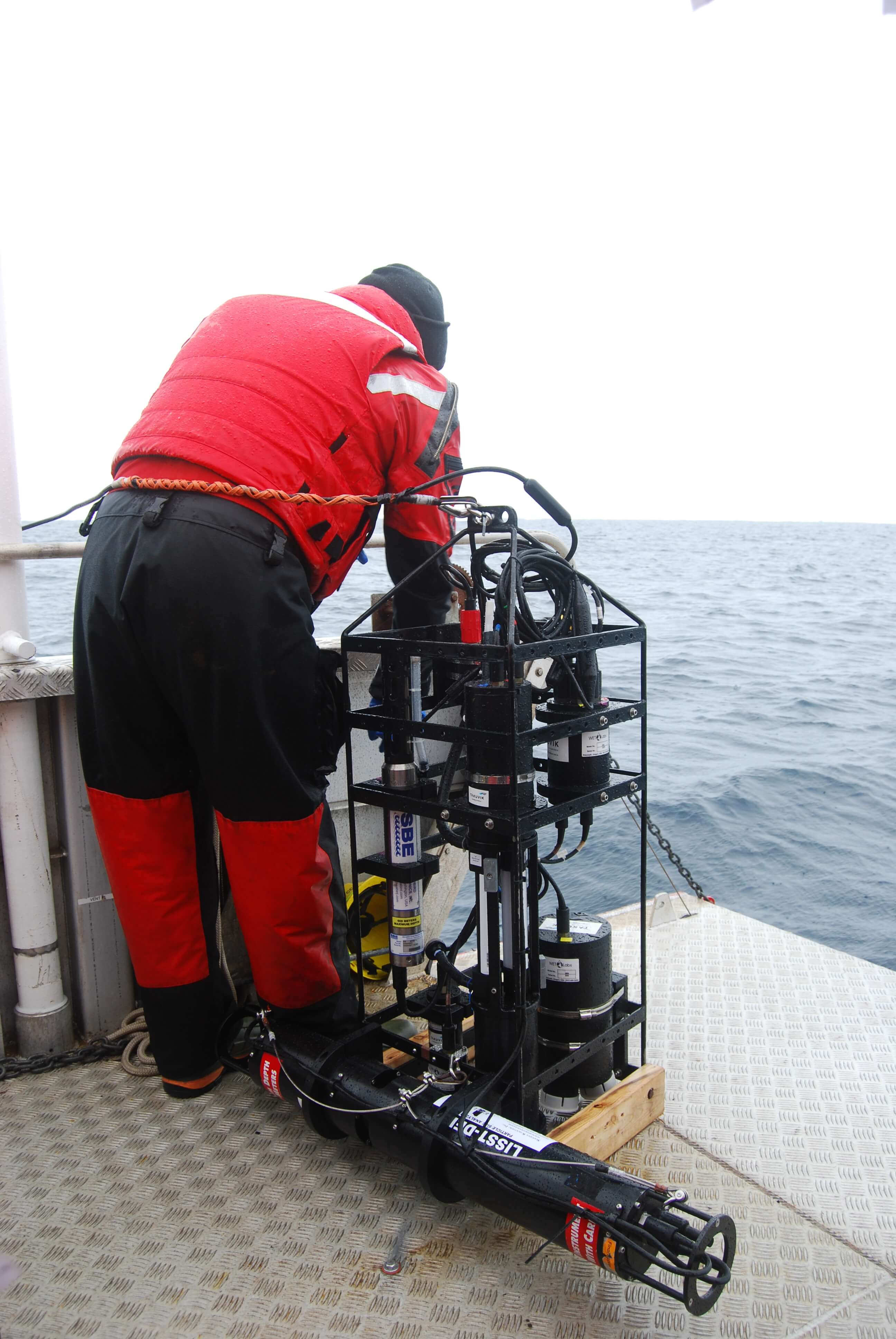
The optical sensors are safe in their cage, ready to be lowered, down into the blue
We are looking forward to discover more about Arctic ecosystems in the research stations we will be visiting across Baffin Bay over the coming days.
Day 4 - The Calm before the Storm
July 15 - by Marion Lebrun, Vanessa Pitusi, Raphaël Larouche and Emiliano Cimoli
Today, we were introduced to remote sensing technologies, which are very important to help us address some of the scientific questions at the core of the School. Through lectures and demonstrations, we learned about powerful tools that harness imagery, artificial intelligence and even satellites (yeah!) to count and classify living and non-living particles in the Arctic Ocean. Very impressive stuff! We were also introduced to robot-like autonomous platforms that are used to reach deeper regions and monitor all kinds of phenomenons in Arctic waters.
What is even more interesting is that we were shown some of the actual so-called “toys”. An ARGO float was shown and described in detail. An ARGO float consists on an automated buoy that wanders the ocean while acquiring meaningful data such as solar light, water salinity and temperature. We can’t wait to be actually testing these technologies in the field in the coming days, what an opportunity!
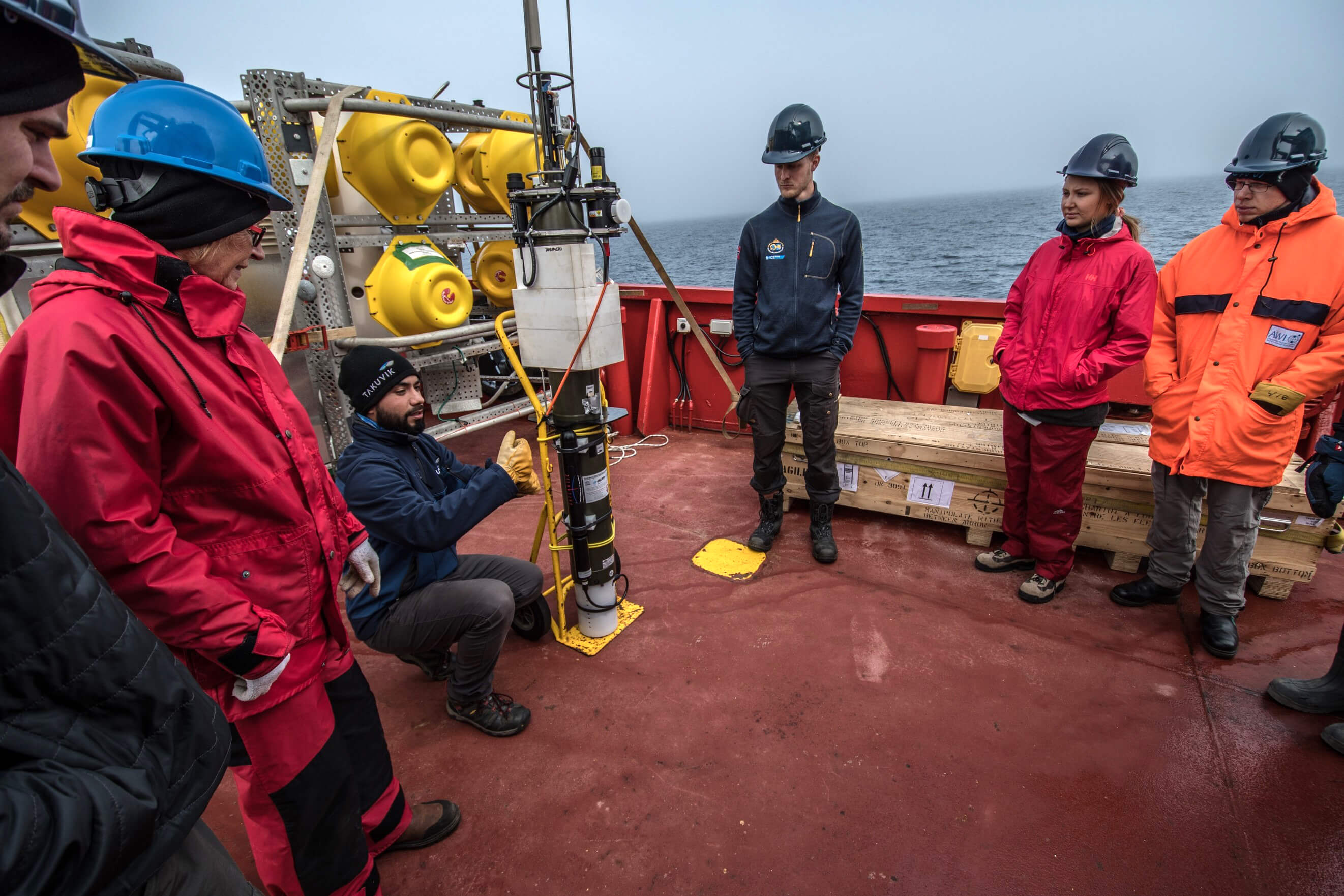
Claudie and José describing the ARGO float
During the lunch break, some of the crew watched the World Cup final – three words: Vive la France!
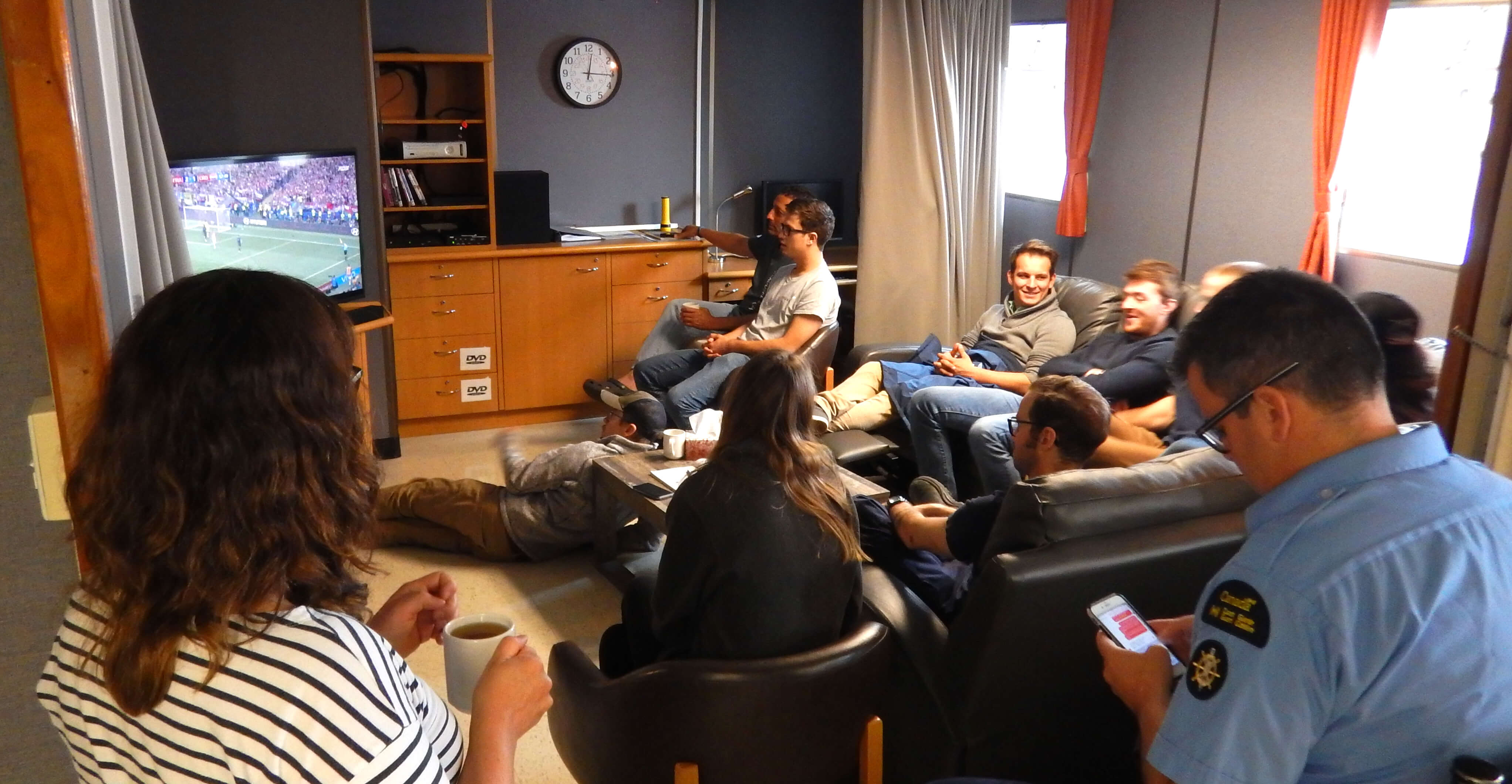
Ship crew and scientists alike intensely watching the World Cup final
Following the familiarization tour of the ship the previous day, we had a practical exercise during the afternoon. By no means was it stressful, but the thought of being stranded in the Arctic Ocean was not quite a comfortable one. The exercise started with an alarm that brought us on deck and had everyone cramped into a lifeboat like sardines in a tin (luckily, it did not smell like one).
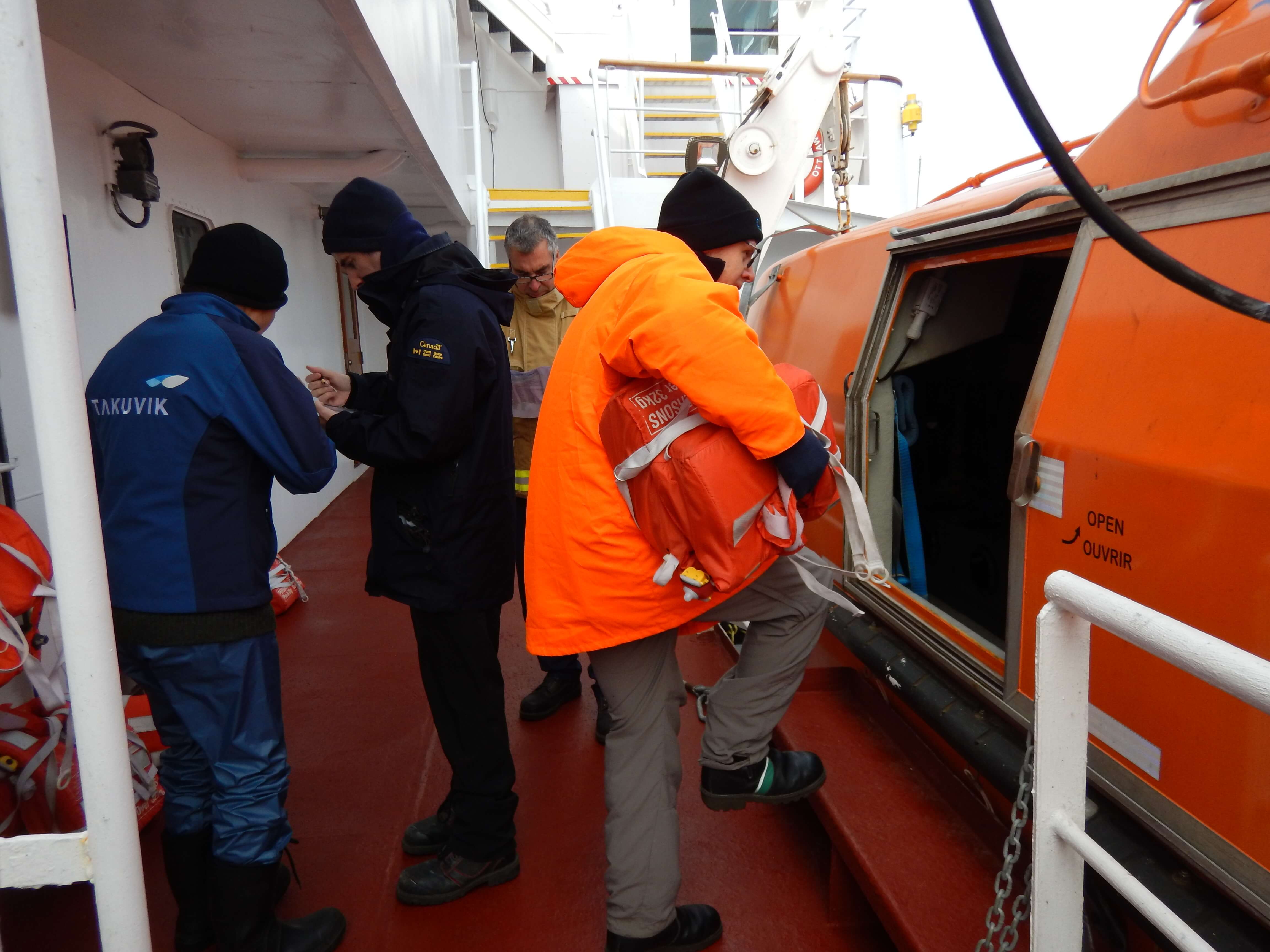
Ready to turn into human sardines
Prior to the emergency exercise, we crossed the 66° parallel, which meant we had entered the Arctic Circle (the goal of the School). Following the crossing, an Arctic initiation followed and we started preparing for our field campaigns with much excitement! We then spent the evening watching a film about the Green Edge project, which fueled the idea behind this Sentinel North PhD summer school – it was really insightful.
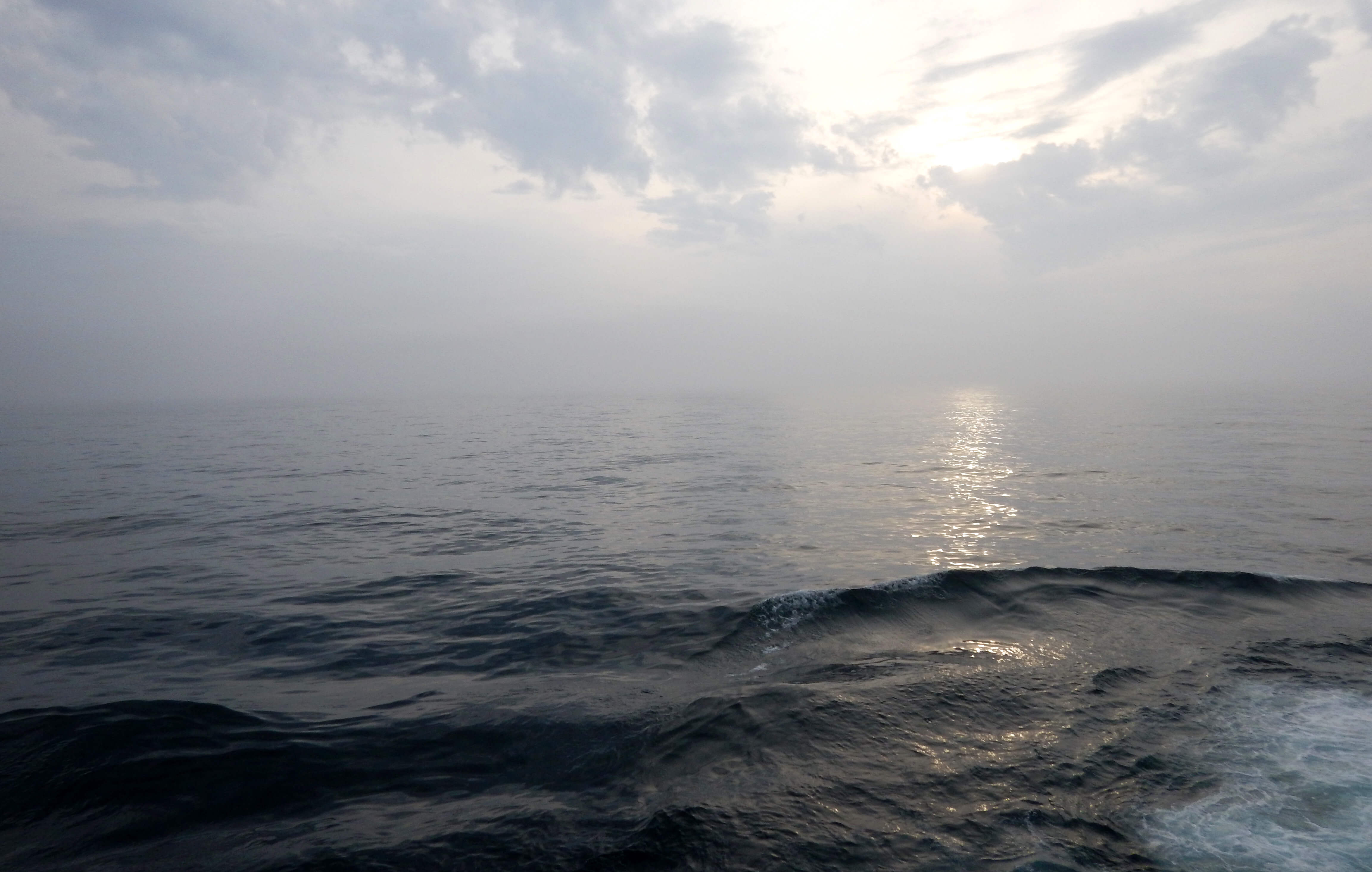
The view isn't that bad, is it?
(Photos by Marion Lebrun)
Day 3 - Breaking ice and meeting polar bears
July 14 - by Marie-France Gévry, Sentinel North training coordinator
We went to bed last night as the ship was being caressed by gentle arctic waves. But when we woke up, the abrupt collisions were telling us that we had reached sea ice. Keeping a firm hand on the safety handle while taking our shower had become a necessity!
We started the day with a first group of elevator-pitch student presentations that allowed us to get to know more about each other's current research projects. Then, lectures about marine optics (AOP, IOP) and sea ice physics were given by Emmanuel Boss and Christian Katlein. The highlight of the day was certainly when the wheelhouse announced there was a family of polar bears on the ice, near the ship! We all ran on the deck with our cameras and enjoyed the sight of a female bear jumping from ice block to ice block with her two cubs. Being so close to them right in their natural habitat made us realise the privilege we have.
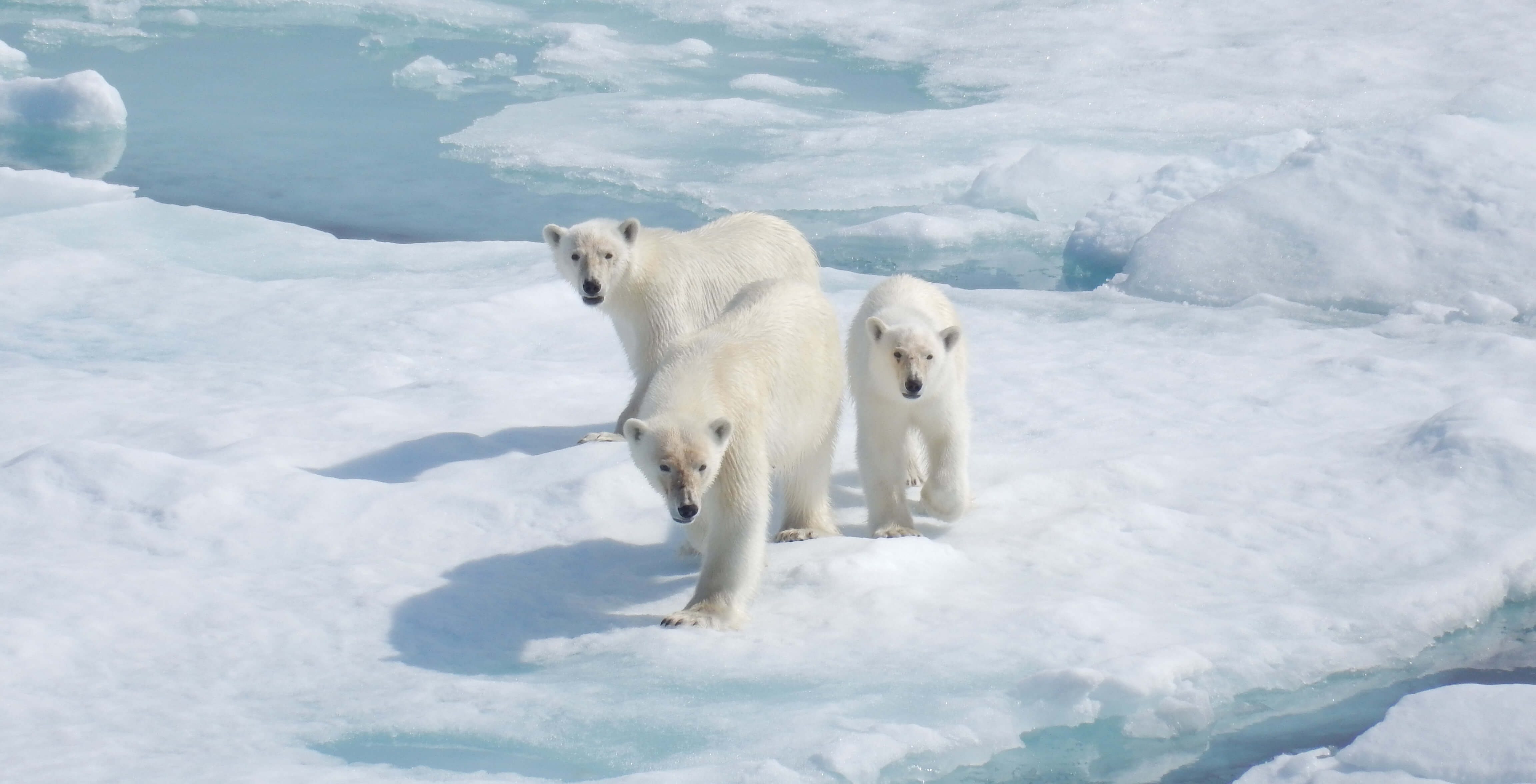
Well, hello you! (photo: Luca Arduini Plaisant)
In the afternoon, we had a familiarization tour of the ship with the coast guard staff, essentially to present us with safety procedures in the case of an emergency. Among other things, we saw the emergency boat that can fit up to 50 people in the case of an evacuation (which we sure hope won't happen!). We also had lectures about ice optics and DMS and regulation services of the ocean by Chrsitian Katlein and Martine Lizotte.

50 people can fit in that emergency boat!
In the evening, chief scientist Marcel Babin showed the most recent local ice maps and explained that the abundance of ice in the Frobisher Bay hindered our progress, and delayed the estimated arrival time to our first research station.

Sea ice is forcing us to review our schedule
We then had a very interesting discussion about the main theme of the School, Arctic marine ecosystem services, which can be either provisioning, regulating, cultural or supporting services. Among other things, we’ve been able to appreciate the importance of the scale (both time and space) and how everything is interconnected. We debated one key question: should we put a monetary value on Arctic marine ecosystem services? Is it dangerous to associate money with ecosystem services? We realised how complex and tricky this issue, as very often we don’t have enough information to establish the value of a species or an ecosystem. Finally, we agreed on the importance of having a more holistic view of ecosystem services.

Our third day ended with a beautiful sundip, as daylight fades out very fast on the Arctic horizon
Day 2 - Boarding the Amundsen
July 13 - by Marie-France Gévry, Sentinel North training coordinator
Today, we all woke up knowing it was going to be a special day, and indeed it was! The excitement was palpable, as it was going to be a "first time" for many of us : first time on a helicopter, first time wearing an immersion suit, first time on an icebreaker ship, and so forth.
The day started smoothly with a series of lectures in Iqaluit. We were first introduced to Arctic biodiversity by Lee Karp-Boss, trying to answer key questions such as "Why should we care about biodiversity?", "Why some regions have more biodiversity than others?", "What are the Arctic environment distinctive traits?" and "How to know if we sample enough to define the biodiversity of the Arctic ocean?". Very instructive.

Lee Karp-Boss, Jean-Eric Tremblay and Vicki Sahanatien shared their expertise in Arctic biodiversity and wildlife
Next, invited speaker Vicki Sahanatien introduced us to the Arctic wildlife and presented the diversity of sea ice habitats and the impacts of their variation in the context of a changing Arctic. Jean-Éric Tremblay, already in the field from the previous Leg (2a) of the Amundsen, joined us on the land to talk about the primary production and nutrients of the Arctic Ocean, and how important they are for the whole food chain. Many of the concepts used to describe the biodiversity and primary production were new for many of us with a physics/engineering background, but everyone was up to the task!
Then the big moment came. We donned the immersion survival suits, somehow feeling like astronauts before take-off! The 5-min helicopter ride to the Amundsen was smooth and offered a scenic view of Frobisher Bay. Finally on board, every participant and mentor took the pace of the ship and began discovered what was going to be their home for the next 12 days.

For most of us, donning immersion suits was a first
The serious stuff continued as we learned the basic concepts of physical oceanography and optics, by Achim Randelhoff and Emmanuel Boss. It was very nice to see the physicists now acting as mentors for other members of the group!

Achim Randelhoff and Emmanuel Boss taught us about physics oceanography
Our day ended up with an "icebreaker" activity to get to know each other a little bit better (without actual icebreaking unfortunately, as we haven’t reach the ice yet!). It was just a perfect day for all of us and a great start to a unique odyssey.
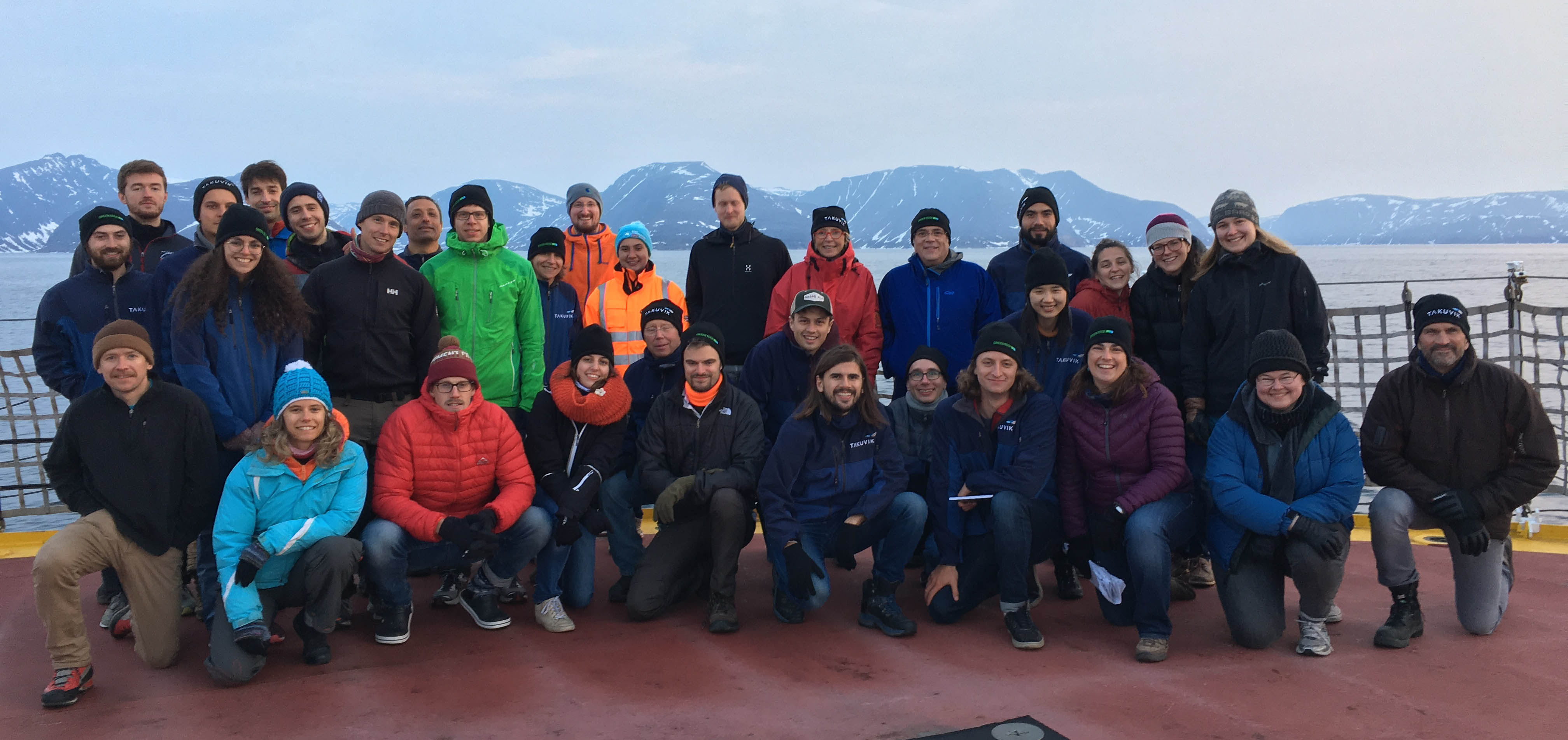
Day 1 - Setting foot north of 64th parallel
July 12 - by Marie-France Gévry, Sentinel North training coordinator
Our Arctic adventure started today, with a scenic flight from Quebec to Iqaluit, capital of the Nunavut territory. The Dash-8 plane was so heavily packed with its 32 passengers and the scientific luggage that 2 stops were required on the way, first in Schefferville and then in Kuujjuaq. With clear blue skies, we could finally see the North and begin to realise its immensity.
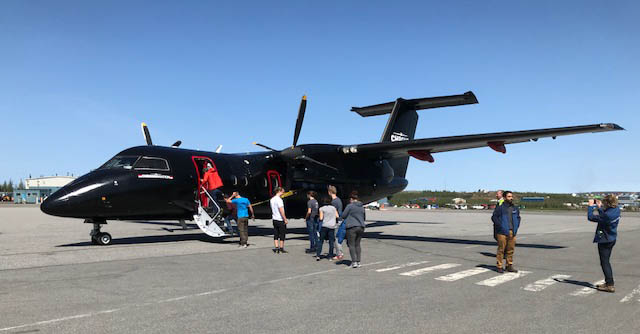
En route!
Six and a half hours later we arrived in Iqaluit and went directly to the Nunavut Research Institute. Chief scientist Marcel Babin first introduced us to the Green Edge Project, its objectives and main work packages. Led by the Takuvik research unit, this project took place in Baffin Bay near Qikiqtarjuaq in 2015-2016. Its aim was to understand and document the spring bloom and its role in the ocean of tomorrow, using remote sensing, paleoceanography, modeling, optics, local knowledge, etc. We ought to provide new insights to the work initiated by the Green Edge Project when the School is finished.
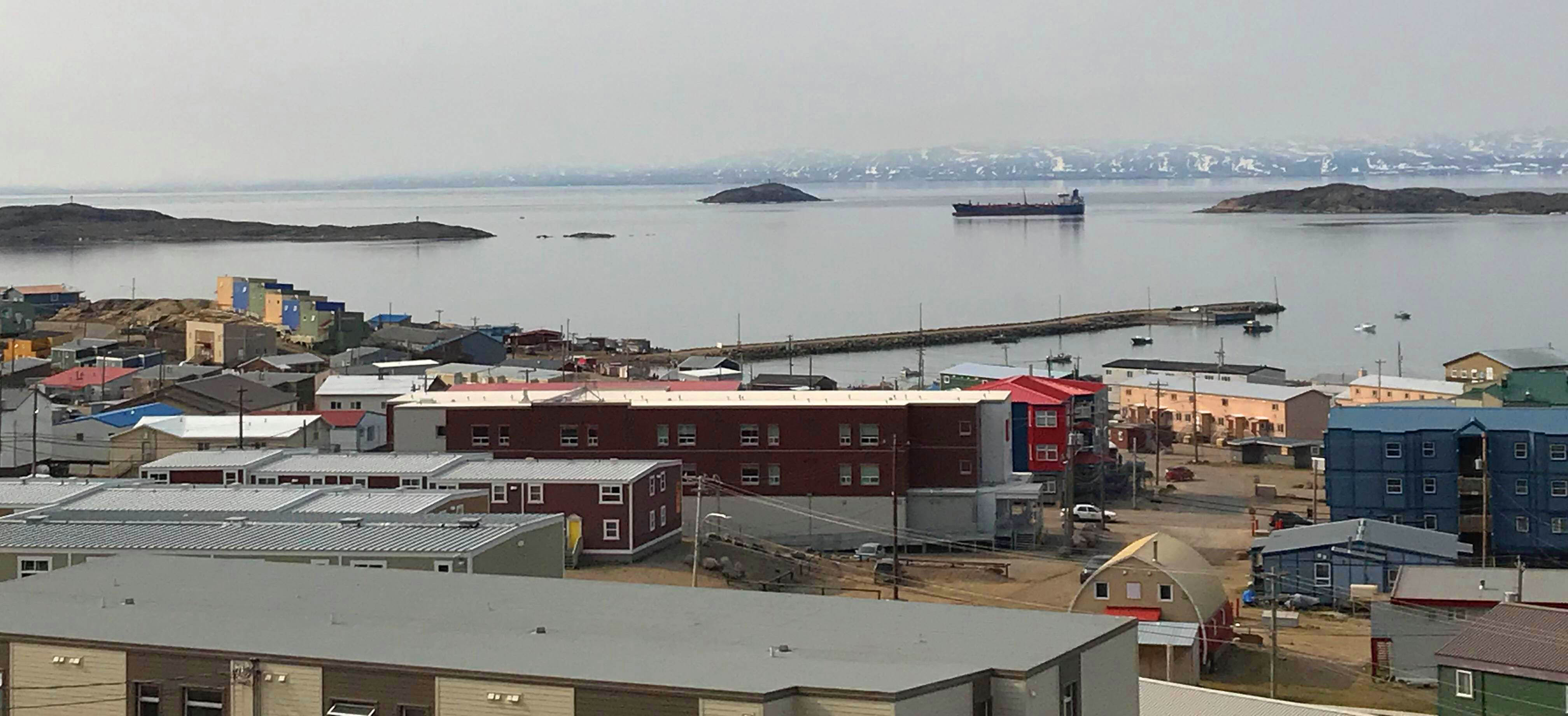
The city of Iqaluit, Nunavut, Canada
The Director of the NRI Mary Ellen Thomas welcomed us with some gifts, explained the role of her organisation, and invited us to discover the city before dinner. The feast was generously hosted by Inukpak Outfitting at Apex Beach, in an old Hudson Bay Company building, and consisted of a traditional meal that begun with a Qulliq lightning ceremony with an elder, Roda. We enjoyed this country food as one brave member of our group dared the Arctic Swim in the radiance of the bonfire, sole light in the northern sky.
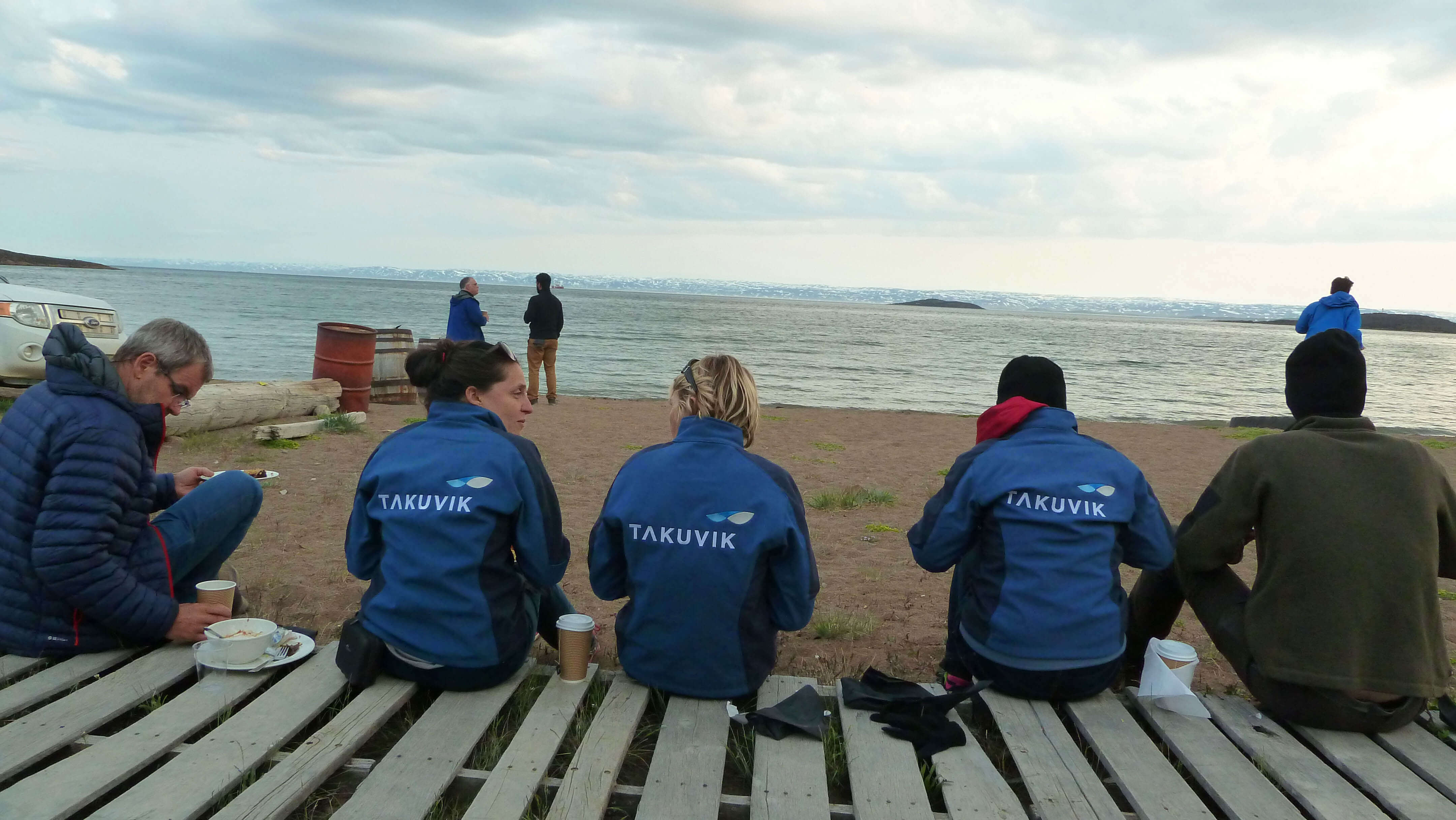
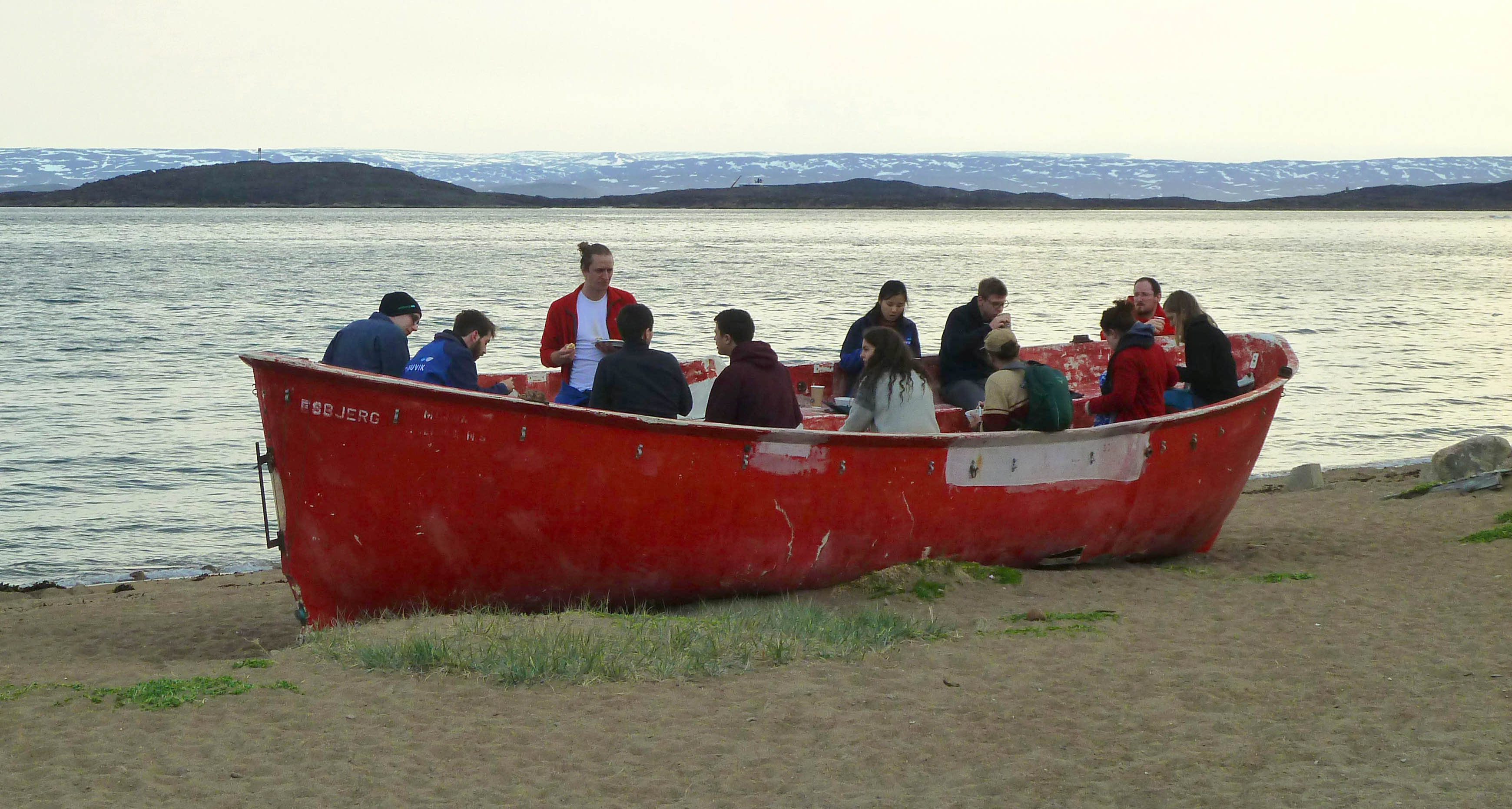
Dinner on the Apex Beach
About the Sentinel North International Ph.D. Schools
As part of the Sentinel North training programs, the International Ph.D. Schools combine a practical approach in northern and/or highly technological environments with the opportunity to interact with high-profile scientists and experts. They provide international students with a chance to learn with world-class research infrastructure as well as specialists from various fields and domains.
This school is possible thanks to a key collaboration with the following partners:
And funding from the Canada First Research Excellence Fund.
Text and photo editing by Jérôme St-Charles.

